Nick Metcalfe's Blog, page 13
January 15, 2015
Company Sergeant Major George Mayer Symons
This is part of a series of essays about the First World War casualties commemorated by the Commonwealth War Graves Commission in Virginia.

Part of a Panoramic Photograph of Camp Lee, 1917
Company Sergeant Major Instructor George Symons was a pre-war regular soldier. In 1918 he was posted to the British Military Mission in the United States, where he died at Camp Lee, Virginia on 8 October 1918 during the influenza pandemic.
George Mayer Symons was born in Holborn, London in the third quarter of 1891—the seventh of the six sons and three daughters of Henry James Symons, a hansom cab driver, and Julia Mary Ann Symons (née Mayer).[1] The family later moved from Holborn to Camberwell south of the river.
George Symons enlisted as a regular soldier in late-1908, aged 18, (L/13400, Private) and joined The Royal Fusiliers (City of London Regiment).[2] He was posted to the 2nd Battalion, which was stationed in India at Jubbelpore (Jabalpur) with a detachment at Pachmarhi Cantonment.
The 2nd Battalion sailed from India in December 1914, arriving in England in early-January 1915. It was based at Stockingford, near Nuneaton in Warwickshire as part of 86th Brigade, 29th Division—the Division was a regular formation made up of battalions that had been recalled from garrison duties across the Empire.
The 29th Division was ordered to the Mediterranean as part of the force that would take part in the Gallipoli campaign. Having been inspected by the King at Stretton-on-Dunsmore on 12 March, 2nd Royal Fusiliers sailed on 16 March on the SS Alaunia from Avonmouth, via Malta to Alexandria. George Symons did not, however, sail with the Battalion.
The reason for him remaining in the United Kingdom is not known—it is possible that he was attending a course of instruction—but he finally embarked for the Mediterranean sometime in August, arriving in that theatre of operations on 25 August.
By the time of his arrival 2nd Royal Fusiliers had seen considerable action. Having landed at X Beach, Cape Helles on 25 April the Battalion suffered half of its strength killed and wounded in three days’ fighting. It was engaged in major actions throughout May and by 7 June had been reduced to only 2 officers and 278 men. Having been withdrawn to Lemnos on 15 July, the Battalion returned briefly to Cape Helles before landing at Suvla on 20 August, where 86th and 87th Brigades took part in the attack on Scimitar Hill the next day; the attack, the last major attack of the Gallipoli campaign, was unsuccessful and 2nd Royal Fusiliers dug in near Chocolate Hill.[3]

Suvla Bay and Anzac Cove, Gallipoli
It was here that Sergeant George Symons rejoined his battalion, with a large draft of officers and men that brought it up to strength for the first time since the landing in April. The Battalion was relieved and embarked for Imbros, where, although safe from the enemy, it suffered 200 more casualties from diarrhoea. The number of casualties suffered in the period since the landing in April is staggering—George Symons was lucky to have avoided becoming one of the 1,736 killed, wounded, missing or evacuated sick.[4] Following his inspection of 86th Brigade, the Commander-in-Chief of the Mediterranean Expeditionary Force, General Sir Ian Hamilton, wrote:
‘11th September, 1915. Imbros. Ran across in the motor boat to see the 86th Brigade under Brigadier-General Percival. Went, man by man, down the lines of the four battalions—no very long walk either! These were the Royal Fusiliers (Major Guyon), Dublin Fusiliers (Colonel O’Dowda), Munster Fusiliers (Major Geddes), Lancashire Fusiliers (Major Pearson).
Shade of Napoleon—say, which would you rather not have, a skeleton Brigade or a Brigade of skeletons? This famous 86th Brigade is a combination. Were I a fat man I could not bear it, but I am as unsubstantial as they themselves. A life insurance office wouldn’t touch us; and yet—they kept on smiling!‘[5]
For two months from late September, when it returned to Suvla, the Battalion held the line near Chocolate Hill—this period included three night attacks and regular patrols. There is no way of knowing what part George Symons played in all of this or whether he was present during the flood that occurred on 26 November:
‘November 26th dawned fine, and so continued until about 5 p.m., when it began to rain. Almost at once it became a characteristic tropical downpour. In an hour there was a foot of water in the trenches. From the hills where the Turks lay a tremendous flood of water swept towards the Fusiliers’ position. The barriers reared so painfully against the Turks were swept away in a flash. In a few minutes the face of the country had changed. Into the trenches swept a pony, a mule, and three dead Turks. Several men were drowned. The whole area became a lake. The communication trenches were a swirl of muddy water. All that could be seen was an occasional tree and a muddy bank where the parados had been particularly high. The bulk of the battalion had scrambled out of the trenches, and stood about on the spots which remained above water, soaked to the skin, and at least half of them without overcoats or even rifles. The moon lit up these small knots of shivering men on little banks of mud in a waste of water. Not a shot was fired on either side. The common calamity had enforced an efficient truce.
Orders came by telephone that the battalion was to hold on to the line at all costs. Meanwhile two orderlies, Frost and James, had been sent to brigade headquarters, and had been compelled to swim most of the way. About 10 p.m. the water subsided slightly, and the men threw up rough breastworks of mud. There they lay huddled together in extreme discomfort, cut through by a piercing wind. The next day the trenches were still from 4 to 5 feet deep, and the men were forced to keep to them. The truce had ended as strangely as it had begun, and any one showing above the trenches was liable to meet the familiar fate. Captain Shaw was shot dead, Lieutenant Ormesher was mortally wounded; and with such object lessons the bitter discomforts of the trenches were made to seem preferable. In the afternoon the wind rose again. It became intensely cold. A blizzard swept the country. Men were sent back to hospital; but some of them died on the way, from exposure and exhaustion. Two of them, belonging to W Company, who shared this fate, had struggled on until they found some sort of shelter near the Salt Lake. There they had paused to rest. The younger of the two could probably have got back to camp alone, but he would not leave his comrade in the storm and darkness and snow. The next morning they were found together—frozen stiff. The younger, his arms round his companion, held a piece of broken biscuit in each frozen hand, and there were biscuit crumbs frozen into the moustache of the elder man.
Under such conditions the tacit truce was renewed. Rum and whisky were brought up to the trenches; but with the utmost difficulty. At midnight on the 27th, the wind was colder, the snow thicker. About 4 a.m. (November 28th) the commanding officer and the adjutant were the only survivors in the reserve line; and it was clear that even superhuman endurance had limits. Permission was obtained to bring the battalion back to the brigade nullah, where the ground was higher and more sheltered. There were only about 300 left in the firing line, and they were got back with great difficulty. Hardly a man could walk normally. The trench was crossed by a single plank. A few of the men were shot as they staggered across. Some failed to get back at all. Others were kicked along with merciful brutality, or they would have given up the struggle. There are few pictures in military history which equal in poignancy that of this little band who, having faced what was almost beyond the power of men, struggled back to life from the very gates of death.
By 7 a.m. the battalion had arrived at the nullah, where they were given warm food and put into blankets. The majority were taken to hospital during the day suffering either from exposure or frost-bite. The strength of the battalion was now 11 officers and 105 other ranks. A party of men, under Second Lieutenant Camies, were sent back to the Dublin Castle post to hold on to next evening. On the 29th it froze hard, and after midnight it was found that the party from another regiment who were to have relieved Second Lieutenant Camies, had lost their way. At 4 a.m. (November 30th) Camies and his men were found still at their posts, but in an almost helpless condition. Sergt.-Major Paschall was sent to take out the relieving party and bring back Camies. The outpost on return all went to hospital, and at 4 p.m. roll call showed only 10 officers and 84 other ranks (70 effective) remaining. The storm had wrought a greater havoc than any battle.’[6]
On 3 January, 2nd Royal Fusiliers finally left the peninsula and sailed for Egypt; by March 1916 it was in France.
It is impossible to say when Sergeant Symons left the 2nd Battalion and, therefore, what experience he had of the Battalion’s actions in France. What is known is that at some time in late-1917 he was detached for duty with the Army Gymnastic Staff (AGS) as a physical training and bayonet fighting instructor, allocated a new regimental number (1125) and then promoted to Company Sergeant Major Instructor.[7] He is likely to have been a regimental physical training instructor and an instructor at a school before applying, or being selected, to join the AGS.

Soldiers on a Physical and Bayonet Training Course for Unit Instructors
The AGS had been formed in 1860 in order to provide a professionally trained cadre of instructors who could develop a more rigorous physical training programme for the Army, and to promote the organisation of sport. It was an establishment, not a corps, and men were attached to the AGS from their parent regiments. Like the rest of the Army, the AGS expanded to cater for the demands of the much bigger wartime Army. At the outbreak of war the Army actively recruited civilian gymnastic and physical training instructors, who were sent to Aldershot—to the School of Physical Training—where they were assessed. Successful completion of this assessment resulted in their appointment as an Acting Sergeant Instructor (or Acting Quartermaster Sergeant or Company Sergeant Major Instructor depending on their level of expertise) and posting to a training establishment or physical training school. Command Schools of Physical and Bayonet Training were established in 1916 to train unit instructors, to train and assess potential AGS instructors from men already serving in the Army, and to provide refresher training. 1916 also saw the establishment of schools in France to support the British Expeditionary Force.[8]
By July 1918, Company Sergeant Major Instructor Symons was held on the supernumerary strength of the 5th (Reserve) Battalion, The Royal Fusiliers and had been posted to the British Military Mission, for employment at one of the United States Army training camps. The training component of the British Military Mission numbered 261 officers and 226 NCOs spread across the training establishment—it was highly regarded and is credited, with its French equivalent, of being pivotal to the successful expansion of the United States Army in 1917 and 1918.
The AGS had provided instructors to the training mission in the United States since October 1917, when 25 officers and NCO instructors arrived and were assigned to the divisions then training.[9] Amongst a contingent of officers and men that sailed from Southampton on RMS Olympic on 27 July 1918, destined for the British Military Mission, was Company Sergeant Major Instructor George Symons.[10] He arrived in New York on 1 August. Also in this contingent of instructors was Captain Harry Daniels VC, MC—he had earned his awards as a company sergeant major with 2nd Battalion, The Rifle Brigade (Prince Consort’s Own) before being commissioned and attached to the AGS.
Symons’ new place of duty was Camp Lee, Virginia. Camp Lee—named after General Robert E. Lee—had been established on farmland acquired by the War Department east of Petersburg in Prince George County soon after the United States entered the war. It was one of 32 cantonments built to cater for 16 National Army and 16 National Guard divisions. Initially, Camp Lee was the home to the 80th ‘Blue Ridge’ Division—recruited from New Jersey, Virginia, Maryland, Delaware, and District of Columbia—which embarked for France in June 1918. Camp Lee then became a training camp for replacements; its major units were the Infantry Replacement and Training Camp, 155th Depot Brigade, one of two Veterinary Training Schools, a school for bakers and cooks, and one of the five Central Officers’ Training Schools for infantry officers.
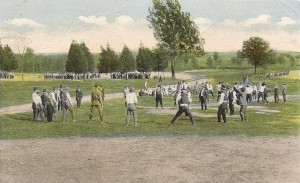
Recruits at Camp Lee exercising with a medicine ball
Company Sergeant Major Instructor Symons arrived at Camp Lee in early August 1918. A month later influenza arrived. The first case was reported on 13 September and the incidence of cases increased rapidly. The camp hospital was quickly overwhelmed and rooms in barracks, and later whole barracks, were set aside for the confinement and treatment of the milder cases. At the same time, blocks of barrack buildings ½ mile from the camp hospital were set up as an annex to the hospital. Quarantine restrictions were imposed to reduce contact with the civilian population, although by then the disease had spread to Richmond.[11] [12] The rate of new infections peaked in Camp Lee in the first week of October; by noon on 3 October 6,449 cases had been reported, resulting in 167 deaths.

Hospital Staff, Camp Lee
George Symons was one of those struck down by the disease during this period. He died at the camp hospital on Tuesday 8 October 1918, one of 28 men to die in that 24 hour period.[13]

Poplar Grove National Cemetery
He was buried at Poplar Grove National Cemetery, Petersburg, one of seven burials in 1918.[16] Poplar Grove National Cemetery was established as a burial site for United States soldiers killed during the Siege of Petersburg. Confederate soldiers were buried at Blandford Church Cemetery. The work to clear the battlefield around Petersburg began in 1866 and was completed by 30 June 1869, when the burial corps that had carried out the work was disbanded. By then 6,178 Union and 32 Confederate soldiers, and five civilians had been buried in the cemetery; only 2,139 are identified. Since then there have been a further 32 Civil War burials (29 in 1931 and three in 2003) and 61 other burials between 1896 and 1957, when the cemetery was closed to non-Civil War interments.[15] George Symons is buried in grave 5596. It is in section C, in a radial row of graves established between 1896 and 1933 in the walkway in the centre of section C; it begins to the right of the gun monument and leads north-east. His grave lies between unknown soldiers in graves 3013 and 3014.
Unfortunately, his grave marker incorrectly records his number, name and date of death; it should read ‘L/13400’ ‘George M Symons’ and give his date of death as ‘8 October 1918’.

The marker for the grave of Company Sergeant Major George Mayer Symons
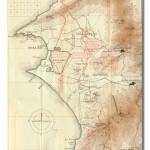
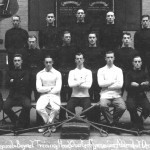
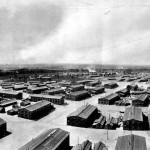
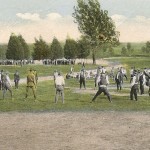

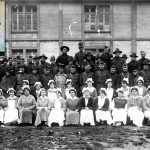
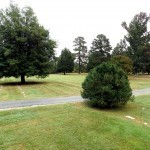
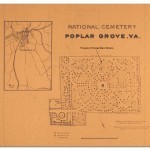
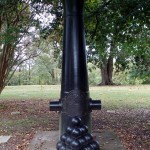
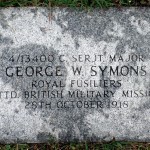
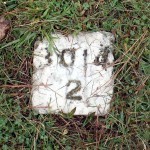
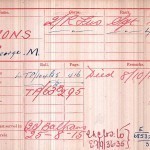
Acknowledgement:
Fort Lee Archive for the photographs of Camp Lee.
Sources:
Anwaerter, J; Curry, G W. (2006). Cultural Landscape Report for Poplar Grove National Cemetery. Boston: Olmstead Center for Landscape Preservation.
Campbell, J D. (December 2003). ‘The Army Isn’t All Work’: Physical Culture in the Evolution of the British Army, 1860-1920. The Graduate School, The University of Maine. Electronic Theses and Dissertations. Paper 185.
Hamilton, I. (1920). Gallipoli Diary. Volume 2. New York: George H. Doran & Co.
O’Neill, H C. (1922). The Royal Fusiliers in the Great War. London: William Heinemann.
Camp Surgeon, Camp Lee, VA. (7 November 1918). Report on the Influenza and Pneumonia Epidemic. RG 112, Records of the Office of the Surgeon General (Army). National Archives.
1. (Back) Henry James Symons (born third quarter 1852) and Julia Mary Ann Mayer (born third quarter 1857) married on 6 September 1876 at Clarkenwell. In addition to George Mayer, they had eight children: Helen Amelia Mary (1877), Selina Julia (14 February 1881), Alfred James (1883), Richard Charles (1885), Arthur Thomas (1887), Albert James (1889), Ernest William (1895), Marian Louise (1897). Selina Julia, Alfred James, Richard Charles, and Arthur Thomas were baptised together on 27 May 1988.
2. (Back) The ‘L’ prefix on his regimental number indicates such a regular enlistment.
3. (Back) The summary of the Battalion’s actions is taken from the wartime history of the Regiment: O’Neill, H C. (1922). The Royal Fusiliers in the Great War. London: William Heinemann.
4. (Back) 19 officers and 260 other ranks were killed; 40 officers and 914 other ranks were wounded; 24 officers and 376 other ranks were evacuated sick and 7 officers and 96 other ranks were missing.
5. (Back) Hamilton, I. (1920). Gallipoli Diary. Volume 2. New York: George H. Doran & Co.
6. (Back) O’Neill. Op. Cit. pp 105-108.
7. (Back) This date is derived from an analysis of other records. In addition, the absent voter list for 1919 (compiled from information submitted in 1918) records him as living at 269 Beresford Street, Woolwich and as being in the Army Gymnastic Staff—1125, Company Sergeant Major.
8. (Back) An excellent history of the Army Gymnastic Staff in the war may be found here: Campbell, J D. (December 2003). ‘The Army Isn’t All Work’: Physical Culture in the Evolution of the British Army, 1860-1920. The Graduate School, The University of Maine. Electronic Theses and Dissertations. Paper 185.
9. (Back) Campbell. Op. Cit. p 212.
10. (Back) The other instructors in this contingent were:
1055 Company Sergeant Major Instructor George Henry Anderson, The East Surrey Regiment
38153 Sergeant Instructor Thomas Coburn, The Norfolk Regiment (formerly The King’s (Liverpool Regiment))
9074 Company Sergeant Major Instructor Charles Alfred Donnithorne DCM, The Border Regiment
8291 Company Sergeant Major Instructor Arthur Gosling, The Cheshire Regiment
9607 Company Sergeant Major Instructor John William Husher DCM, The Duke of Wellington’s (West Riding Regiment)
TR/8/11617 Sergeant Instructor Albert Clement Locker, The Devonshire Regiment (formerly 940, The Royal Warwickshire Regiment)
1727 Company Sergeant Major Instructor Daniel McConville, Army Gymnastic Staff (formerly 10599 The Gordon Highlanders) 7/17
8721 Quartermaster Sergeant Instructor John Thomas Murray, The South Wales Borderers
38076 Sergeant Instructor Walter Rushworth, The Norfolk Regiment
38009 Sergeant Instructor Stanley Frederick Smith, The Norfolk Regiment
10530 Company Sergeant Major Instructor William Robin Thomas DCM, The Cameronians (Scottish Rifles)
1147 Company Sergeant Major Instructor William Wilcox, Army Gymnastic Staff (formerly 8836, The South Wales Borderers)
1658 Sergeant Instructor Arthur James Wilkinson, Army Gymnastic Staff (formerly 10841, Coldstream Guards)
34227 Sergeant Instructor Percy Hutchings, The Loyal North Lancashire Regiment
A number of other instructors in that contingent have not been positively identified (it is believed that they include some Canadian NCO instructors): William Denton, William Edwards, John Thomas Harper, James Hughes, Donald McDonald, Frederick Preston, Charles Price, James Fred Seaton, Henry Duncan Sheldon, Alfred V Smail, (?) Smith.
In addition to Captain H Daniels VC, MC, there were 29 officers on board: Brigadier General L R Kenyon, Director of Munitions Inspection; Captain C E Ashby MC, The London Regiment—an officer of the British Military Staff in Washington DC; 23 other officers of the British Military Mission (including two Canadians, Captain L Kirk-Greene, 5th Battalion Canadian Mounted Rifles, and Lieutenant John McWatters, Canadian Infantry); three officers of the British Naval Mission; and an officer returning to the British West Indies from sick leave. Most of the instructor officers were appointed as at 19 July in London Gazette 26 September. Issue 30920, pp 11405-406 (the officers appointed to the British Military Mission on 12 July in the same Gazette (and three Canadian instructor officers) had arrived in the United States on RMS Mauritania a week earlier).
11. (Back) Camp Surgeon, Camp Lee, VA. (7 November 1918). Report on the Influenza and Pneumonia Epidemic. RG 112, Records of the Office of the Surgeon General (Army). National Archives.
12. (Back) Here you can read more about the influenza pandemic in Camp Lee and Richmond.
13. (Back) In the report produced by the Camp Surgeon at Camp Lee the strength of the command was reported as 49,300 all ranks. Between 13 September and 7 November 1918, there were 11,637 cases of influenza and 1,960 cases of pneumonia, resulting in 674 deaths. In a smaller outbreak in December 692 cases were reported, of whom four died.
14. (Back) It is acknowledged that some of the Civil War soldiers buried here may not have been United States citizens.
15. (Back) Anwaerter, J; Curry, G W. (2006). Cultural Landscape Report for Poplar Grove National Cemetery. Boston: Olmstead Center for Landscape Preservation.
16. (Back) The burials in 1918 were all First World War casualties:
Private Charlie Favors, 155th Depot Brigade, Camp Lee; died on 16 March 1918; C5594
Private Arthur H. Heward, 155th Depot Brigade, Camp Lee; died on 12 June 1918; C5595
Private Mike Kosich, 155th Depot Brigade, Camp Lee; died on 9 January 1918; C5593
Captain Arthur L. Lynn, 8th Cavalry; died at Presidio, Texas on 11 October 1918; C5598
Private Stanley Urbanowicz, 3rd Camp Development Battalion, Camp Lee; died on 5 October 1918 C5597
Private Frank D. Williams, 465th Motor Truck Company; died in France 26 September 1918 and buried at American Cemetery 4, Neufchateau. Reinterred at Poplar Grove National Cemetery C3447A
January 8, 2015
The Evolution of the Regular and Service Battalions of Princess Victoria’s (Royal Irish Fusiliers) 1914-1918 – Part 6, The 9th (Service) Battalion (County Armagh)/9th (North Irish Horse) Battalion.
This essay describes the evolution of the 9th (Service) Battalion (County Armagh)/9th (North Irish Horse) Battalion. The background to this essay may be found here.
This material is taken, from Blacker’s Boys Appendix 6; it has been summarised and is updated here based on new information received since publication.

‘B’ Company, 9th (Service) Battalion, Princess Victoria’s (Royal Irish Fusiliers) (County Armagh) in early-1915
The First to Enlist
The first men to enlist into the County Armagh Battalion of the 2nd Brigade of the Ulster Division did so over six days beginning on 15 September 1914. Uniquely in the history of the Regiment, the men of this first draft were all Protestant and many were members of the Ulster Volunteer Force. They were mainly from County Armagh, with the majority from the north of the county around Lurgan and Portadown. There were some men from Counties Cavan and Monaghan, the other traditional recruiting areas for Princess Victoria’s (Royal Irish Fusiliers), and some from Counties Down and Antrim, and from Belfast.
The reported strength of the new battalion, when it formed at Clandeboye Camp on 21 September 1914, was 842 men. A little over forty more joined over the next few days before regimental numbers were issued. Of this first batch of recruits, the first to enlist in the County Armagh Battalion, 781 men have been identified by name.[1]
Of the known men, 652 sailed with the Battalion for France in October 1915. For a further 41 men there is no record of when they deployed to France and joined the Battalion.[2]
Enlistments between October 1914 and July 1915
Following the arrival of the first volunteers at Clandeboye, recruiting continued apace. Recruits joined the 9th Royal Irish Fusiliers at Clandeboye directly until the formation of the depot company, which became responsible for the basic training of recruits after the Battalion left for Seaford in July 1915. This responsibility passed to the 10th (Reserve) Battalion when it was formed in September 1915. In general, men who enlisted before the 9th Royal Irish Fusiliers moved to Seaford embarked for France with the Battalion in October 1915. Those who enlisted after July 1915 joined later as reinforcements from the 10th (Reserve) Battalion.
The absence of complete records makes it impossible to determine exactly the number of men who enlisted into the 9th Royal Irish Fusiliers and the number discharged under King’s Regulations or transferred in the months that followed their enlistment. Nevertheless, it is possible to identify 440 men who enlisted between October 1914 and July 1915 and who joined the Battalion.
Of these, 17 men were discharged or transferred; 358 men are known to have embarked with the 9th Royal Irish Fusiliers in October 1915; and 65 men served with the Battalion in France but they joined sometime after the main body had arrived.
In summary, the lowest estimate of enlistments between September 1914 and July 1915 is 1,282 men—1,221 have been identified by name. Of these, 1,010 are known to have landed in France with 36th (Ulster) Division in October 1915, with a further 106 men arriving in France sometime later.[3] The remainder were discharged, or transferred, or were posted elsewhere.
It is noteworthy that 332 of these men, a third, were killed in action, died of wounds, or died of illness, injury or accident.
Reinforcement Drafts
Following a period of familiarisation and training, the Battalion took its turn in the line north of Albert throughout the first half of 1916. 36th (Ulster) Division spent most of this time in two sectors astride the River Ancre with the 9th Royal Irish Fusiliers, and the other battalions of 108th Brigade, in the northern sector at Hamel.
Until the attack at Hamel on 1 July 1916, small drafts and individual reinforcements arrived from the 10th (Reserve) Battalion. These new men had enlisted in the latter half of 1915 and early 1916 and were from the same Ulster Protestant background as the Battalion’s original members. In addition to the large reinforcement drafts detailed below, as the war progressed the 9th Royal Irish Fusiliers also received men from all of the other battalions of Princess Victoria’s (Royal Irish Fusiliers) as they filtered through the reinforcement cycle. These men were a mix of regular soldiers, men recalled from the Army Reserve, men who had enlisted as Special Reservists, and wartime volunteers. They also represented both Catholic and Protestant communities and, although mainly from County Armagh, they came from all over Ireland. They also reflected the drafts from English regiments that had been transferred to other battalions of Princess Victoria’s (Royal Irish Fusiliers), as explained in other essays. Many of those who had seen previous service had recovered from wounds, injury or sickness.
The first reinforcement of English soldiers took place after the attack on 1 July 1916. The attack had destroyed this fine battalion—it suffered 541 killed and wounded—and the 10th (Reserve) Battalion could not bring it fully up to strength again. On 8 August 1916 a draft of eighty-eight men of The Sherwood Foresters (Nottinghamshire and Derbyshire Regiment) arrived.[4] This was followed by a draft of 103 men, mostly of The London Regiment, on 26 November.[5] The final body of reinforcements to arrive in 1916 comprised 89 men of The Prince of Wales’s Own (West Yorkshire Regiment) that arrived on 12 December.
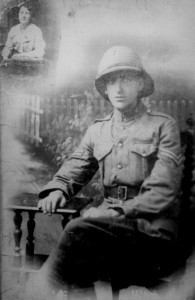
Corporal (later Company Quartermaster Sergeant) F MacMahon
After the attack on 1 July 1916, and having been reconstituted, 36th (Ulster) Division moved north to Ypres, where it went into the line near Wytschaete. The 9th Royal Irish Fusiliers suffered a trickle of casualties as it held the line and raided along the River Douve and at Spanbroekmolen. It was not until the attack on 16 August 1917, the Battle of Langemarck, that the Battalion was again nearly destroyed and in need of massive reinforcement—on that occasion it suffered 456 officers and men killed, wounded and captured.
In September the largest draft to join the Battalion since its formation arrived. It comprised over 570 men compulsorily transferred for duty as infantry from the disbanded 2nd North Irish Horse, X Corps Cavalry Regiment. The majority of the Battalion now comprised the men of the North Irish Horse and it was duly renamed the 9th (North Irish Horse) Battalion.
The final action of note in 1917 was the attack at Moeuvres during the Battle of Cambrai in November 1917, in which the Battalion suffered 89 all ranks killed and wounded.
Following the reorganisation of the infantry of the British Expeditionary Force in early 1918, the 7th/8th Royal Irish Fusiliers was disbanded. The war diary of the 9th Royal Irish Fusiliers records that a draft from the disbanded battalion arrived comprising 213 men.[6]
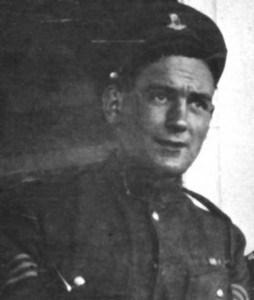
Sergeant F S Homersham DCM, MM
In late-March and early-April 1918 the 9th Royal Irish Fusiliers suffered grievously for the third time being all but destroyed in the retreat from St Quentin and at Ypres. At this time the reserve battalions of the Irish regiments were reorganised compounding the problem of the lack of Irish reinforcements. The fourth draft of English soldiers was the second from The London Regiment and comprised 122 men. The Battalion also received a small draft of 14 men transferred from The Royal Irish Rifles.
On 8 June the Battalion was brought closer to its full strength by a large draft of 186 men, most of whom had been compulsorily transferred for duty as infantry from the Army Service Corps (105) and the Army Veterinary Corps (68).
The final phase of the war began for the 9th Royal Irish Fusiliers with an attack in August 1918 north-west of Bailleul and the Battalion was then in almost constant action until 26 October. In this period it received its final draft of reinforcements—137 men transferred from The Royal Irish Rifles.

‘B’ Company, 9th (North Irish Horse) Battalion, Princess Victoria’s (Royal Irish Fusiliers), Mouscron, November 1918
Details on each of these drafts may be found here: Princess Victoria’s (Royal Irish Fusiliers) 1914-1918 – Reinforcement Drafts
Back to ‘The Evolution of the Regular and Service Battalions of Princess Victoria’s (Royal Irish Fusiliers) 1914-1918‘ main page.
1. (Back) Detail about the enlistments into the 9th Royal Irish Fusiliers between September 1914 and July 1915 may be found here.
2. (Back) This is based on an analysis of medal rolls and medal index cards. The records may be incomplete. Most of these men will have arrived in France by early 1916.
3. (Back) The Battalion’s war diary reported that it landed in France with a strength of 995 other ranks; the discrepancy is a small one (15 men) and likely to be explained by men on the advance party or detached for duty elsewhere.
4. (Back) The Battalion’s war diary reported it as being 90 men strong.
5. (Back) The Battalion’s war diary records that the full draft was made up of ‘34 Irishmen, 102 Englishmen and 1 Russian’. It is known that the ‘Russian’ was from The London Regiment.
6. (Back) The war diary of the 7th/8th Royal Irish Fusiliers records it being 220 men strong.
January 4, 2015
My Family in the First World War – Part 5: John Palmer Bowes
504226 Private John Palmer Bowes
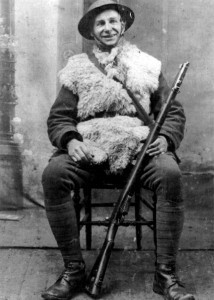
Private John Palmer Bowes. 2nd Canadian Division Mechanical Transport Company, Canadian Army Service Corps.
John Palmer Bowes was my wife’s maternal great-grandfather. He was born at Oakwood in the township of Mariposa[1] in Ontario, Canada on 29 March 1869, the second youngest of the five children of Emmanuel and Elizabeth Bowes.[2] The family moved to Kansas City, Missouri in 1890, where Emmanuel re-established his business as a grocer. John later moved to St Louis and became a motor mechanic. In 1901 he married Emma Leming (née Young), a widow with three children from her first marriage.[3] Their son, Emanuel Adrian, was born at their home at 4120 Blair Avenue, St Louis on 12 December 1906.
By 1910 John was working as a mechanic for the Underwriter Salvage Corps. The Salvage Corps was created in 1874—it worked alongside the city’s fire patrols and would enter burning buildings to remove valuable items before they were destroyed. Sometime in 1914 John decided to move his family back to Canada. They settled in Edmonton, where they occupied a house at 11257 Jasper Avenue West, and where John went to work as a mechanic for Edmonton Fire Department.
John Palmer Bowes enlisted for service with the Canadian Expeditionary Force on 28 February 1916, declaring his year of birth as 1878—shaving nine years off his age, making him just under 38 and of military age. He joined the Canadian Corps of Royal Engineers (504226, Sapper) and, after a period of initial training, he sailed for England on the RMS Baltic on 21 May 1916, arriving on 30 May. He immediately joined the Engineers Training Depot at Shorncliffe in Kent. The first Canadians had arrived in the spring of 1915 and the Canadian Training Division was based here in five large barracks.[4]
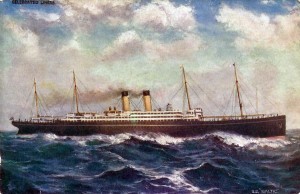
RMS Baltic
After training at Shorncliffe for three months his age began to tell and, in early September 1916, he reported sick with muscle pain, and a painful and swollen knee (he had also suffered from rheumatism), at which time he also declared his true age. As a result, a medical board assessed that he was unfit for ‘general service’ but that he was suitable for ‘permanent base duty’, at home and abroad.[5] He was posted to the strength of the Canadian Casualty Assembly Centre at Monks Horton, an administrative holding unit for hospitalised soldiers and those not fully fit, from 7 September 1916 and attached to the Engineers Training Depot for duty.
In mid-1917, however, his level of fitness and his previous employment as a mechanic resulted in his transfer to the Canadian Army Service Corps on 26 July. The Army Service Corps was responsible for transportation and supply services and, with an increasing reliance on motor vehicles, needed suitably trained and experienced men. Read more about the Canadian Army Service Corps.
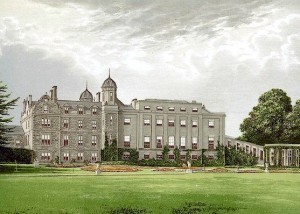
Eastwell Manor
At about 8.30pm on 1 October 1917, while walking back to barracks, Private Bowes, as he was now, was hit by a car. He was admitted to Moore Barracks Canadian Hospital,[6] Shorncliffe—X-rays on 2 October 1916 showed that he had not, as first thought, broken his spine, ribs or shoulder. He was sent to a convalescent home at Eastwell Park at Ashford[7] and, after treatment and rest, he was discharged on 24 October. While undergoing his convalescence he was posted to the Canadian Army Service Corps Depot at Bramshott in Hampshire, which he joined after his convalescence.
At a medical board on 23 November he was again passed fit for ‘permanent base duty’—based on his age and his old knee injury—but on 8 December 1917 Private Bowes again joined the Canadian Army Service Corps Base Depot at Shorncliffe and six days later was assigned to a draft of men to be sent to France. He arrived in France on 15 December and after a week at the General Base Depot he was posted to the Canadian Corps Supply Column on 22 December as a reinforcement. He remained with that unit until 12 March 1918, when he was posted to the Canadian 2nd Division Supply Column. A month later, he joined the Canadian 2nd Division Mechanical Transport Company on 14 April. It was with this unit that he would spend the rest of the war.

‘Battle Flash’ of 2nd Canadian Division MT Company
The 2nd Canadian Division had been raised in late-1914 and it sailed for England in May 1915. After completing a period of training at Shorncliffe it arrived in France over the period 15-18 September 1915, at which time the Canadian Corps was formed. The Canadian Corps was one of the most highly regarded fighting formations of the war. By the time Private Bowes arrived in France in the spring of 1918, it comprised four infantry divisions. From June 1917, it was commanded by a Canadian officer—Lieutenant General Sir Arthur Currie, one of the Allies’ most effective corps commanders.[8]
Private Bowes first major action was the Battle of Amiens, which began on 8 August 1918 when the Canadian Corps attacked alongside an Australian Corps in the opening offensive of the final phase of the war. Read more about the Battle of Amiens.
There then followed the series of Allied attacks known as the ‘Hundred Days Offensive’ that led ultimately to the Armistice. The 2nd Canadian Division’s final actions were the Second Battle of Cambrai, 8-10 October 1918, and the Pursuit to Mons in the last days of the war. John Palmer Bowes finished his war in Belgium near Frameries, south of Mons.
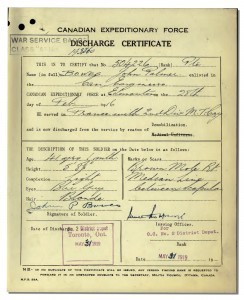
Discharge Certificate for Private John Palmer Bowes
Following the Armistice the Canadian Corps became part of the Army of Occupation and Private Bowes was stationed near Bonn in the Rhineland until the Canadians returned to Belgium at the end of January 1919. The 2nd Division was then based in the area of Auvelais, ten miles west of Namur, but it would be some months before the Canadian Divisions were finally disbanded.
Private Bowes returned to England on 29 April 1919 and sailed for Canada on the RMS Aquitania on 18 May, arriving in Halifax, Nova Scotia on 25 May. On his return to Canada, he was taken on strength at No. 2 District Depot, Toronto from which he was discharged on 31 May 1919 and he rejoined his family in Edmonton. Read more about repatriation and demobilization.
The family remained in Edmonton for the next decade, and John returned to work as a mechanic for Edmonton Fire Department. Sometime before 1930 the family moved back to St Louis, where John continued to work as a mechanic and later as a chauffeur and truck driver. In his later years, he became estranged from his wife and, from June 1939, he spent his final years being cared for by the Little Sisters of the Poor at their residence for the needy elderly at North Florissant Avenue in the St Louis Place neighbourhood; he died there on 10 August 1947, aged 78. He was buried in Calvary Cemetery, St Louis on 12 August 1947. His grave is unmarked.
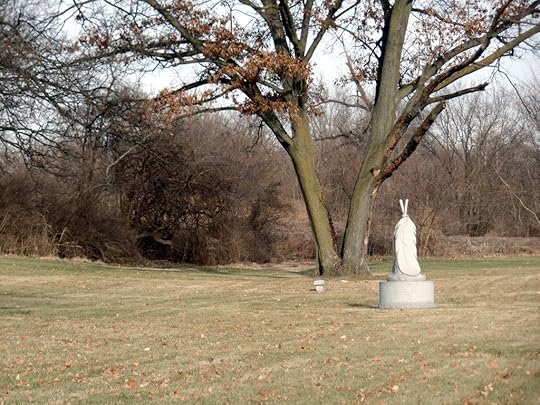
Calvary Cemetery, St Louis
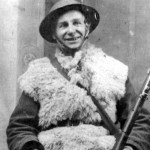
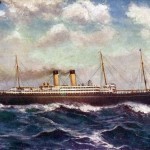
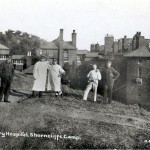
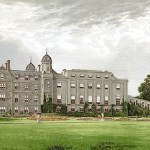

Acknowledgment:
Archive of the Little Sisiters of the Poor, St Louis.
Ian Boyle, Simplon Postcards, for the image of the RMS Baltic.
1. (Back) Now part of Kawartha Lakes, Ontario.
2. (Back) His father, Emmanuel A Bowes, a grocer, was born on 19 January 1835 in Ontario, Canada. His mother, Elizabeth Horsley, was born on 5 April 1838 in England. Emmanuel died on 8 March 1903 and Elizabeth died on 7 August 1918—they were buried together in Elmwood Cemetery, Kansas City.
3. (Back) Emma Young was born on 28 July 1865 in Pennsylvania, the daughter of a German immigrant father. She married William Bruce Leming on 20 December 1884 and had three children: Frank Rust (born 24 June 1886), Irene May (born around 1888), and (Daniel) Bruce (born 12 July 1891). William Leming died in 1899.
4. (Back) Ross Barracks, Somerset Barracks, Napier Barracks, Moore Barracks and Risborough Barracks.
5. (Back) The difficulty in employing overage men who were not fully fit (and, indeed, underage boys) placed a considerable strain on the Canadian Expeditionary Force depots in England. On 20 September 1916, Colonel Herbert A. Bruce produced a report on the Canadian Army Medical Service, which studied the fitness of the CEF after 31 July 1916. His findings were critical of the medal examinations being conducted at enlistment. As regards unfit men, he wrote: ‘Unfits in England are a great bother. They take the places on base duty of men who have been at the front and have a prior claim on any soft jobs available. Others clog up the hospitals, increasing the strain on the already overtaxed medical services.’ He wrote about overage men: ‘In the last four months we have had over 1,000 recommended for permanent base duty from over age, with an average age of 49 to 50 years for each man. It is a common occurrence for the men, when questioned as to their given age when enlisted, to make a statement that they gave their true age as 54 or 55 years, as the case may be, and the medical officer said they would call him 41 or 42 years. In one case he was informed by the soldier that, on enlistment, the recruit on giving his proper age was told to run around the block, think over his age, and come back again. …One of the over-age men was found to be 72 years old.’
6. (Back) Later renamed No. 11 General Hospital.
7. (Back) Eastwell Manor is a large country house in Eastwell Park near Ashford in Kent. It was built between 1540 and 1550 for Sir Thomas Moyle—a commissioner for Henry VIII in the dissolution of the monasteries, and speaker of the House of Commons. The building was added to in the 18th and 19thC. It was the home of Prince Alfred, Duke of Edinburgh, the second son of Queen Victoria, until 1893. During the First World War it was a convalescent hospital, largely for Canadian troops. After a fire in the 1920s it was rebuilt and it is now a country house hotel and spa.
8. (Back) General Sir Arthur (William) Currie GCMG, KCB was born on 5 December 1875 in Ontario. He served with 5th Regiment, Canadian Garrison Artillery from 1897, being commissioned in 1900. In 1909 he was promoted to lieutenant colonel and was given command of the Regiment. In October 1913 he was given command of 50th Regiment (Gordon Highlanders of Canada). Command of 2nd Canadian Brigade followed on the outbreak of war and his sure handling of the Brigade resulted in him being made a Companion of the Order of the Bath (CB), his promotion to major general and command of the 1st Canadian Division. He was instrumental in the success of the Canadians at Vimy Ridge in April 1917, for which he was knighted, being appointed KCMG. He was promoted to lieutenant general on 9 June and given command of the Canadian Corps. He was made KCB in 1918 and GCMG in 1919. In 1919, he became the first Canadian promoted to the rank of General. He died on 30 November 1933, aged 57, and was interred in Mount Royal Cemetery in Montreal.
December 22, 2014
HMS Warrior
This is part of a series of essays about the First World War casualties commemorated by the Commonwealth War Graves Commission in Virginia.
Private Elmer Robert Darrock, Royal Marine Light Infantry
Engine Room Artificer 2nd Class Harold Gurney Davis, Royal Naval Reserve
Deck Hand William Kelly, Mercantile Marine Reserve
Deck Hand Joseph Prowse, Mercantile Marine Reserve
Private James Schofield, Royal Marine Light Infantry
Writer 3rd Class Thomas Henry Symons, Royal Navy
Deck Hand Herbert Thomas, Mercantile Marine Reserve

HMS Warrior
If the society pages of the Washington Post, the Washington Herald and the Washington Times are to be believed, HMS Warrior[1] provided a focus for some of the social whirl in Washington DC during the final months of the war. The influenza pandemic curtailed many of the normal opportunities for social gatherings but, in the words of one commentator, writing about the reception given for Sir Eric Geddes, then the First Lord of the Admiralty, who was visiting the United States:
‘A more impressive or significant party than the reception given to the distinguished foreign visitors could not be wished for than that aboard the British flagship Warrior, given by Vice Admiral and Lady Grant, who made the trip across on board some months ago. The Warrior is their Washington home and a charming one it is, out in the historic Potomac. It is by special permission of the admiralty that Vice Admiral Grant is accompanied on the Warrior by Lady Grant. The party on Wednesday was the first assembling of society this season, and it was not only a brilliant occasion but a happy reunion. The soft, familiar blue of the French uniforms, with a dash of red here and there, the gay trappings of our own and British, Italian and Canadian officers, both of army and navy, made a significant scene on decks, as well as a picturesque bit of colour against the somber gray of the sturdy warship.’[2]
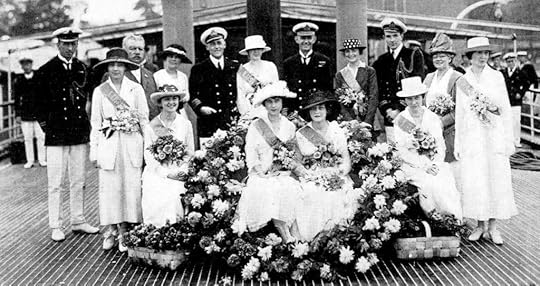
The Daughters of the American Revolution Aboard HMS Warrior
The society pages did not, however, comment upon the importance of the presence of Vice Admiral Sir Lowther Grant, who had been in Washington since March. His primary concern was the protection of convoys in the north-west Atlantic and he sought greater participation by the United States Navy in anti-submarine operations. Sir Eric Geddes’ visit followed an increase in U-Boat activity in August and September 1918—although the dire warnings about a further increase in such attacks proved unfounded—and he hoped to push the United States into a quicker completion of its warship building programme, which was many months behind schedule. The presence in Washington DC of Vice Admiral Grant, Commander-in-Chief on the North American and West Indies Station, and his flagship HMS Warrior, was eminently sensible, given the complexity of the relationship between the Admiralty (and its policy of maintaining the effort in home waters), the Canadians and the United States.
Warrior, a luxurious steam yacht, designed by the Scottish naval architect George Lennox Watson and built for Frederick W. Vanderbilt, a scion of the Vanderbilt railway and shipping empire in 1904. In early 1914, after she had been grounded at the mouth of the River Magdalena on the Colombian coast, the 1,266-ton, 284 feet-long yacht was bought by Harry Payne Whitney. In early 1915, Whitney, a philanthropist businessman and sportsman, and Vanderbilt’s nephew by marriage, sold the ship to his brother-in-law, Alfred G. Vanderbilt, who renamed her Wayfarer. He did not own the ship for long—Alfred Vanderbilt was drowned when RMS Lusitania was sunk by U-20 on 7 May 1915—and the yacht was bought from his estate in 1916 by Alexander S. Cochran. Cochran, a wealthy philanthropist and yachtsman, restored her original name, Warrior.[3] His period of ownership was not wholly happy either—Warrior ran aground on Fishers Island, Long Island Sound in July 1916. This is a short video of Warrior taken in the 1930s (note that the design number is wrong, Warrior was ‘424’):
Warrior was hired by the Admiralty in February 1917 for service on the North American and West Indies Station and, armed with two 12-pounder 3-inch naval guns, served as HMS Warrior, an armed yacht with pendant number 090.[4] Her first deployment was to the Caribbean in July 1917.
The crew was a mix of Royal Navy, Royal Naval Reserve, Mercantile Marine Reserve and Royal Marine Light Infantry. The Royal Naval Reserve comprised men who were professional seamen of the Merchant Navy and fishing fleets and who undertook a month’s training every two years, primarily in gunnery. The Mercantile Marine Reserve comprised merchant seamen who served under a special wartime Naval engagement and were subject to Admiralty regulations and the Naval Discipline Act.[5] The Royal Marine Light Infantry (amalgamated in 1923 with the Royal Marine Artillery to form the Royal Marines), were shipborne infantry responsible for conducting boarding parties and for ship security.
HMS Warrior spent the first part of her war in the Caribbean. She arrived there from Bermuda in July 1917 spending most of the next six months in the Lesser Antilles but also visiting Jamaica and Belize. On 19 January 1918 she sailed from St Lucia back to Bermuda, where she arrived on 23 January. The next three weeks were spent here, cleaning and preparing the yacht for her role as the flagship of Vice Admiral Sir Lowther Grant KCB.
Vice Admiral Grant had been appointed Commander-in-Chief on the North American and West Indies Station on 7 January and had joined his flagship, HMS Highflyer, at Devonport on 23 January 1918. After an uneventful journey via the Azores, HMS Highflyer arrived in Bermuda on 10 February. Having completed the transfer of equipment and personnel to the new flagship, over the next few days HMS Warrior was readied for sea. Vice Admiral Grant raised his flag on the morning of 16 February 1918 and at noon HMS Warrior sailed for Halifax, Nova Scotia.
HMS Warrior arrived at Halifax three days later on 19 February where she remained until she sailed for Washington on 23 March. She sailed down the eastern seaboard, into the Chesapeake Bay and up the Potomac River, coming alongside at Washington on the morning of 27 March; she would remain berthed at the confluence of the Potomac and Anacostia rivers at Washington Barracks[6] as Vice Admiral Grant’s flagship for the rest of the war, and the residence for him and his wife, who had accompanied him to Washington.
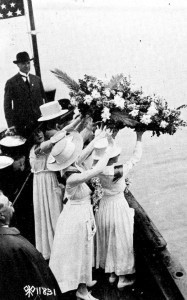
Launching the Daughters of the American Revolution Floral Wreath
In addition to the routine of ships maintenance, the yacht’s compliment enjoyed liberty in Washington and took part in a number of ceremonies and social functions in support of Vice Admiral Grant’s role, many of which were hosted by his wife. The first large event of note was on Memorial Day, Thursday 30 May.[7] The commemoration in 1918 was unusual. A ceremony planned to commemorate those who died in the sinking of RMS Lusitania was widened to include all of those who had died up to that date in the war. It began on board HMS Warrior and then moved to the USS Wicomico, a yard tug; it was from the latter that large wreaths were ‘launched down the historic Potomac River and above which the ‘Union Jack’ had been raised’. The ceremony also featured ‘a bevy of American girls, flanked by a group of British jack tars, and hydroplanes circling above dropping flowers on the scene’.[8] Thereafter, the receptions and social engagements hosted onboard were a regular feature in the local press reports.
Against this backdrop of strategic military debate and social engagement, the first cases of influenza were observed in Washington DC in August 1918. They were initially confined to the naval station and local army camps but by the end of September civilian cases were increasing and, in early October, schools were closed and four emergency relief stations and an emergency hospital were opened (although the city’s Black population was not similarly catered for until the end of the month). By early November the epidemic was seen to be in decline and restrictions were lifted but cases increased again in December. The epidemic continued until February 1919 by which time there had been over 33,000 cases and 2,895 deaths. It was ‘one of the more devastating epidemics in the nation’.[9]
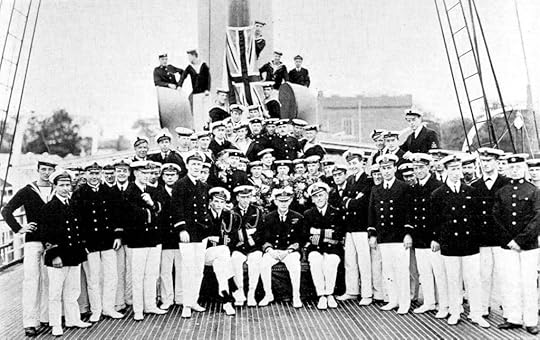
The crew of HMS Warrior, 30 May 1918
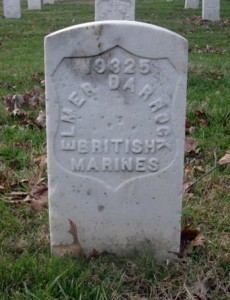
The Original Grave Marker for Private Elmer Robert Darrock
The log of HMS Warrior records 46 discharges to hospital between 6 August and 22 December—a substantial majority of her crew.[10] [11] Seven of these men succumbed to influenza, or to complications related to it in the New Naval Hospital at 23rd and E Streets NW.[12] They were buried in Arlington National Cemetery—the burial parties in all cases were provided by HMS Warrior’s crew.[13] With the exception of Harold Gurney Davis, all of the men are buried in Section 17, on the western side of the cemetery near the Confederate Memorial; Davis is buried nearby in Section 15A. The graves were originally marked with similar headstones to those used through Arlington National Cemetery but they have recently been replaced with Commonwealth War Graves Commission headstones.
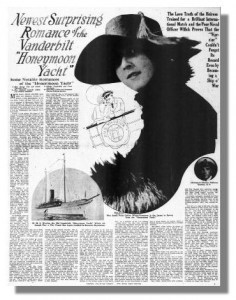
Romance on HMS Warrior
The final remarks about HMS Warrior reflect, again, the impact that the ship, the Admiral and his wife, and her crew had on Washington’s social scene. Lady Grant had left Washington soon after the Armistice but the romance that she had helped ignite between Lieutenant Charles Fellowes-Gordon and Miss Sara Price Collier, a cousin of the Assistant Secretary of the Navy and future President Franklin D. Roosevelt dominated the society press reports in November and December 1918. After the turn of the New Year, a series of functions were held to say goodbye to HMS Warrior’s crew, beginning on 3 January 1919 with a dance held by the crew at a venue ashore (the link to the right will take you to a typical society column from this period).
Sadly, three days later Deck Hand Joseph Prowse succumbed to influenza; he was the final crew-member to die. He was buried on 8 January and a little over a week later, on 17 January 1919, almost 10 months after her arrival, HMS Warrior left Washington DC.[14] Admiral Sir Lowther Grant (he had been promoted on 1 September 1918) sailed in HMS Warrior as far as New York before crossing the Atlantic on the RMS Adriatic, with departing senior members of the British Military Mission.
PLY/15645 Private Elmer Robert Darrock, Royal Marine Light Infantry
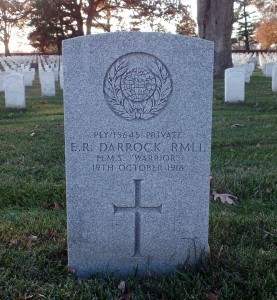
Private Elmer Robert Darrock, Royal Marine Light Infantry
Elmer Robert Darrock was born on 19 December 1894 at Cardiff in Wales—evidence points to his name being mis-spelled and that the correct spelling is ‘Darroch’.[15] On leaving school, he followed his brother and joined the Great Western Railway on 1 March 1909 as a lamp boy. He enlisted at Bristol into the Royal Marine Light Infantry on 25 March 1912. After his initial training, which included a period on the battleship HMS Exmouth, he joined the compliment of HMS Thunderer, an Orion-class battleship, on 10 September 1913 and on which he served until November 1916, seeing action at the Battle of Jutland. After a period of time ashore, he joined HMS Highflyer on 13 April 1917. Highflyer was then refitting in Gibraltar. She went to sea on 11 May and sailed to Plymouth before visiting Sierra Leone on 4 June, and then sailing for Bermuda, where she arrived on 23 June to join the North American and West Indies Squadron. There is no record of when Darrock joined HMS Warrior but given that Highflyer sailed immediately for Halifax, and that Warrior was about to sail for the Caribbean, it is possible that it was just after he arrived in Bermuda.[16]
Private Darrock was sent to hospital (with Deck Hand J Prowse, see below, and Leading Deck Hand D Murdock) on 10 October suffering from influenza—he died of pneumonia at 8.30am on 19 October 1918, aged 23. He was buried on the afternoon of 22 October. His grave is number 19325 in Section 17. Elmer Robert Darrock is also commemorated on the Grangetown War Memorial, Cardiff and in the Welsh National Book of Remembrance at the Welsh National Temple of Peace and Health in Cardiff.

Grangetown War Memorial
Engine Room Artificer 2nd Class Harold Gurney Davis, Royal Naval Reserve
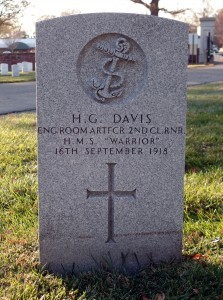
Engine Room Artificer 2nd Class Harold Gurney Davis, Royal Naval Reserve
Harold Gurney Davis was born in 1886 at Seaview on the Isle of Wight, where he was christened on 23 January 1887. His father was a master mariner, and Harold and his brother Lionel both became maritime engineers. He married Olive Hill in the latter part of 1915 and they lived at Eddington, in St Helens.
Harold Davis was rated as an Engine Room Artificer 2nd Class—the equivalent of a Chief Petty Officer—but is referred to in HMS Warrior’s log as ‘Engineer Warrant Officer’. There were at least three such engineers on board in this period. All went to hospital while Warrior was in Washington. The first, R Russell was sent to hospital in Colorado in June 1918 to be treated for tuberculosis; he was discharged in November. J A Thompson was sent to hospital on 29 September suffering from influenza; he survived and was discharged a week later. Harold Davis was not so lucky. He had been sent to hospital on 13 September 1918 and died of thrombosis of the mesentery vein at 1.30pm on 16 September 1918, aged 32.[17] He was buried on the afternoon of 19 September. His grave is number 84-NS in Section 15A. Harold Gurney Davis is also commemorated on the Isle of Wight County War Memorial in the Church of St Nicholas in Castro, Carisbrooke—the chapel, founded in the 11thC, was reconstructed in 1904, reworked as the county war memorial by local architect Percy Stone and dedicated in 1929. He is also commemorated on the Seaview Parish War Memorial, which is built into an exterior wall of St Peter’s Church, Seaview; on the wooden triptych in the south aisle of St Peter’s Church; and by an inscription on his parents’ gravestone in St Helens Cemetery.

Seaview War Memorial
Deck Hand William Kelly, Mercantile Marine Reserve
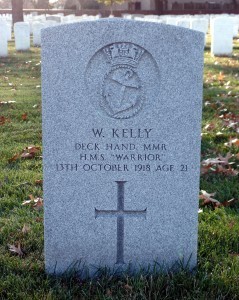
Deck Hand William Kelly, Mercantile Marine Reserve
William Kelly was born to Richard and Mary Kelly—from County Cork—in 1897 in Poplar in the East End of London, where his father worked on the docks. He was the youngest of six children. A merchant seaman, he served with the Mercantile Marine Reserve as a crew-member on HMS Warrior; there is no record of any other service.
Deck Hand Kelly was sent to hospital on 30 September 1918, with Sub Lieutenant E G Old, Warrant Engineer J A Thompson and Steward R J Goulden, all of whom were suffering from influenza. He died at 7.30am on 13 October, aged 21, and was buried on the afternoon of 16 October. His grave is number 19399 in Section 17.
Deck Hand Joseph Prowse, Mercantile Marine Reserve
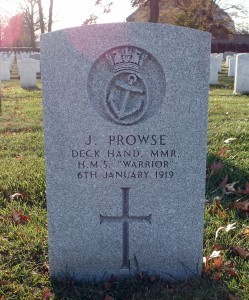
Deck Hand Joseph Prowse, Mercantile Marine Reserve
Joseph Prowse was born on 21 May 1893. He was a merchant seaman rated ‘able’ when he joined the Royal Naval Volunteer Reserve on 28 October 1915 (MB/572, Motorboatman). He served first on the Motorboat Resourceful at Southampton until 10 January 1916, when he joined HMS Hermione, the depot ship for the motor boat patrol.[18] On 13 September he joined HMS Europa, the flagship at Mudros, Greece for service with the Motorboat Penelope. From November 1916 he was administered by HMS Victory II (one of a number of similarly named, shore-based, administrative locations) until 22 March 1917. In this period his movements are not known but may have involved his transit to Bermuda. His record is annotated that he then transferred to the Royal Naval Reserve and had signed to acknowledge his wartime Naval engagement and being subject to Admiralty regulations and the Naval Discipline Act.[19] Sometime after March 1917 he found himself in the North American and West Indies Squadron and a crew-member on HMS Warrior.
Deck Hand Prowse was sent to hospital (with Private E R Darrock, see above, and Leading Deck Hand D Murdock) on 10 October suffering from influenza—he died on 6 January 1919, aged 25. He was buried on 8 January.[20] His grave is number 19515 in Section 17.
PO/B/992 Private James Schofield, Royal Marine Light Infantry
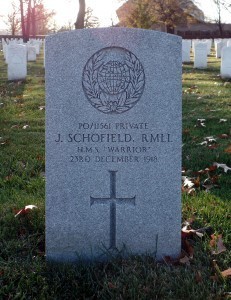
Private James Schofield, Royal Marine Light Infantry
James Schofield was born on 10 October 1882 at Bradford in Manchester, the third of seven sons and a daughter of Richard and Mary Ann Schofield. Like their father, the seven boys all became miners in the Manchester coalfield. James sought an alternative employment, however, and enlisted in Manchester on 11 June 1901 into the Royal Marine Light Infantry (PO/11551, Private). His first period of sea service began on 28 May 1902 when he joined HMS Duke of Wellington, the sail and steam powered, first-rate, which had been launched in 1852. She was decommissioned in 1903 and, after a short period ashore, Private Schofield joined HMS Imperieuse, an elderly cruiser, for a few weeks until 1 October 1903 when he joined HMS Hawke, a re-commissioned cruiser used to ferry crews to the Cape. From May 1904 he served ashore until he joined HMS Good Hope on 8 February 1906. Private Schofield remained with Good Hope, the flagship of the 1st Cruiser Squadron of the Atlantic Fleet, until 22 July 1907, when he briefly joined HMS Prince George in the Home Fleet. His final periods of sea service before joining the Royal Fleet Reserve, were with the cruiser HMS Argonaut from September 1907 to August 1908, when he joined HMS Venus, upon its return from the Quebec tercentenary celebrations. Private Schofield was transferred to the Royal Fleet Reserve on 27 June 1909.
He attended his drill periods annually until 1913 when he volunteered for transfer to the Immediate Class, the Fleet’s high readiness reserve (renumbered PO/B/992). Following the outbreak of war he was mobilised on 10 August 1914 and joined HMS Leviathan. He spent almost all of the war on Leviathan, an armoured cruiser, which, following a period spent hunting German raiders and escorting convoys, became the flagship of the Commander-in-Chief on the North American and West Indies Station, arriving in Bermuda on 26 March 1915. Private Schofield transferred to HMS Highflyer in Halifax in July 1918 before joining HMS Warrior on 17 August in Washington.
Private Schofield was sent to hospital on 20 December 1918 (with the Officer’s Chief Cook W J Labett), where he died of pneumonia on 23 December, aged 36. In a double burial ceremony, he was interred on the afternoon of 24 December beside Writer Symons. His grave is number 19518 in Section 17. He is also commemorated on Denton War Memorial.
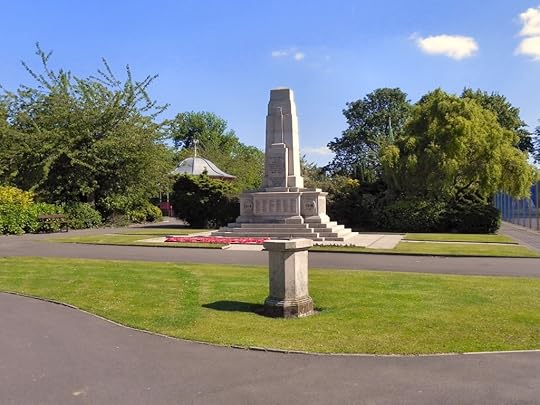
Denton War Memorial
M/18229 Writer 3rd Class Thomas Henry Symons, Royal Navy
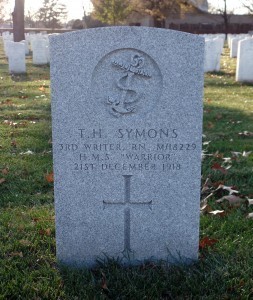
Writer 3rd Class Thomas Henry Symons, Royal Navy
Thomas Henry Symons was born on 8 May 1893 at Liskeard in Cornwall, the third of six children. He worked as a solicitor’s clerk before he enlisted into the Royal Navy on 10 January 1916. He joined HMS Highflyer on 16 June 1916, where he served until he joined HMS Warrior on 30 August 1918.
Writer Symons was sent to hospital on 17 December and died of pneumonia on 21 December 1918, aged 25. In a double burial ceremony, he was interred on the afternoon of 24 December beside Private Scofield. His grave is number 19519 in Section 17. He is also commemorated on Liskeard War Memorial.
Deck Hand Herbert Thomas, Mercantile Marine Reserve
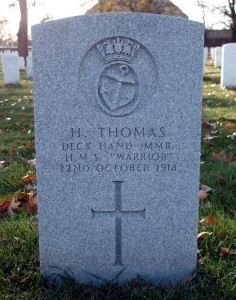
Deck Hand Herbert Thomas, Mercantile Marine Reserve
Herbert Thomas was born in 1887 at Liverpool. He became a merchant seaman; it is not known when he joined HMS Warrior.
Deck Hand Thomas was sent to hospital on 8 October 1918 (with Cook A J Edney and Assistant Cook F J Trim) and died of pneumonia on 22 October 1918, aged 31. He was buried on the afternoon of 24 October. His grave is number 19400 in Section 17.
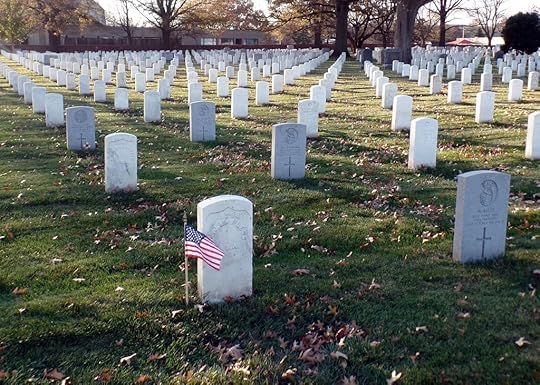
The Graves of Private J Schofield, Writer T H Symons and Deck Hands H Thomas and W Kelly
Acknowledgements:
Dix Noonan Webb for the photograph of the Mercantile Marine Medal.
David Dixon for the photograph of Denton War Memorial (under a creative commons licence).
Amanda Fulcher, archivist for the National Society of Daughters of the American Revolution, for providing the photographs of the 1918 Memorial Day ceremony.
International Wargraves Photography Project for the photographs of the original grave markers in Arlington National Cemetery.
John Greyson for the photograph of Grangetown War Memorial (under a creative commons licence).
Kevin Quick for the photograph of Seaview War Memorial.
Sources:
Naval-History.Net. This is an outstanding resource for those studying the Royal Navy in the 20thC. In particular, the site provided me with the transcriptions of the logs of the ships mentioned.
Newspapers.com.

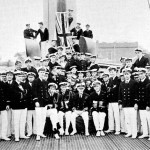
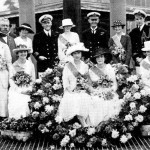
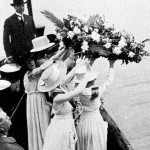
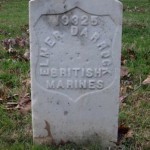
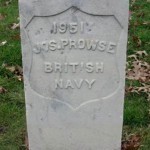
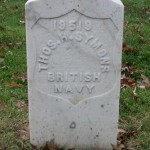
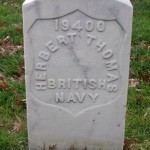
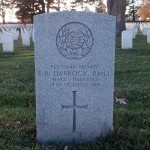
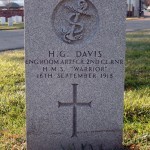
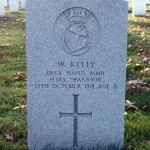
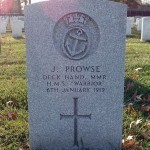

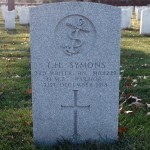
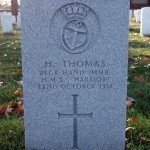
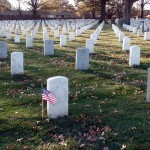
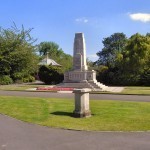
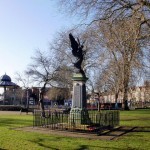
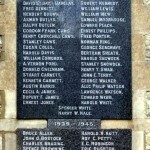
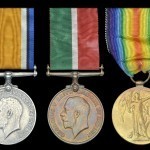
1. (Back) HMS Warrior is referred to in some sources as ‘HM Yacht’ or ‘HMY’ Warrior. The ship’s log uses the term ‘HMS’, as do the graves of the men who died, and that is the term that I have used throughout.
2. (Back) ‘Society’. (13 Oct 1918). The Washington Post. p 29.
3. (Back) ‘Spokes from the Rudder Wheel.’ (May 1916). The Rudder. Volume 32, number 5, p 244. New York: Rudder Publishing.
4. (Back) Known as ‘pennant number’ since 1948. See Naval-History.net.
5. (Back) Form T124. This form was also used for men serving with the Royal Naval Reserve Trawler Section and for mercantile marine officers commissioned into the Royal Naval Reserve.
6. (Back) Now Fort Lesley J. McNair.
7. (Back) Memorial Day, the commemoration of those who died serving in the armed forces, was traditionally held on 30 May until 1968, when it was moved to the last Monday in May.
8. (Back) ‘Memorial Services, Lusitania Victims.’ (August 1918). Daughters of the American Revolution Magazine. Volume 52, number 8, pp 486-487.
9. (Back) Influenza Encyclopedia produced by the University of Michigan Center for the History of Medicine and Michigan Publishing, University of Michigan Library.
10. (Back) Twenty-five men are specifically annotated as suffering from influenza and three from pheumonia.
11. (Back) The exact size of the ship’s compliment is not known but the photograph of the crew taken on 30 May 1918 shows 59 officers, warrant officers, ratings and marines, not including the Admiral and his three staff officers.
12. (Back) The hospital building, behind the Old Naval Observatory, on what was known as Observatory Hill or, more recently, Potomac Annex is part of a historic site that is being redeveloped and renovated for the US Department of State.
13. (Back) It should be noted that the numbering of the sections of Arlington National Cemetery differs from the locations as described by the Commonwealth War Graves Commission.
14. (Back) HMS Warrior was released from service in January 1919. She was bought in 1920 and renamed Goizeko Izarra (Basque – Morning Star)—in which guise she was used to evacuate children from Bilbao during the Spanish Civil War—and again in 1937, when she reverted to the name Warrior. Requisitioned again during the Second World War, she was named HMS Warrior II. On 11 July 1940 she was bombed and sunk in the English Channel. Chief Steward John William Collins, Naval Auxiliary Personnel (Merchant Navy), aged 60, was killed in the attack. He is buried in Portland Royal Naval Cemetery. Collins had served in The Border Regiment for four years before enlisting into the Royal Navy in 1909. He served throughout the First World War (Mentioned in Despatches) and was discharged in 1928.
15. (Back) See: (a) General Register Office. (First quarter 1895). England and Wales Civil Registration Indexes. Volume 11a, p 345. (b) The National Archives (TNA). Public Record Office (PRO). Census Returns of England and Wales, 1891. (c) TNA. PRO. Census Returns of England and Wales, 1901. (d) TNA. PRO. Census Returns of England and Wales, 1911. (e) TNA. PRO. Great Western Railway Company: Staff Records. RAIL264, piece 432. (f) Other references include his brother’s marriage and death registration etc.
16. (Back) He could also have joined HMS Warrior later—a number of crew-members joined HMS Warrior from, and were discharged to, HMS Highflyer, while Warrior was alongside in Washington.
17. (Back) Reported as ‘…the effects of Spanish influenza.’ See: ‘The Island and the War. Seaview.’ (28 September 1918). Isle of Wight County Press. p 8.
18. (Back) For an account of service with motor boats see: Maxwell, G S. (1920). London: The Motor Launch Patrol. J M Dent and Sons [online at Internet Archive].
19. (Back) The only men of the Royal Naval Reserve engaged in this manner (i.e. with Form T 124) were trawlermen who crewed craft engaged in minesweeping and similar duties. The record indicating this transfer to the Royal Naval Reserve and Prowse being recorded as Mercantile Marine Reserve at the time of his death cannot be reconciled. He is recorded on the Royal Naval Volunteer Reserve and Mercantile Marine Reserve medal rolls, the former referencing the latter.
20. (Back) District of Columbia, Deaths and Burials, 1840-1964. This record records his name as ‘Prouse’.
December 11, 2014
My Family in the First World War – Part 4: Robert Thompson
18/1141 Lance Corporal Robert Thompson
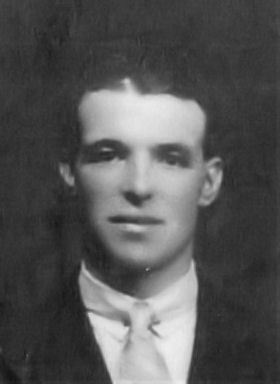
Robbie Thompson
My great-uncle Robbie was the eldest of the twelve children of Henry and Margaret Thompson, and the only one old enough to serve during the First World War.[1] He was born at Hyde Park, Mallusk in County Antrim on 25 December 1898 and enlisted, considerably underage, on 1 December 1915, a little less than a month short of his 17th birthday.
Robbie enlisted into The Royal Irish Rifles, the county regiment, intending to join the locally-raised 12th (Service) Battalion (Central Antrim), which was one of nine battalions of the Regiment in 36th (Ulster) Division.[2] By the time that he enlisted, the Ulster Division had completed its training and was in France, getting to grips with life in the trenches, and Robbie joined the 18th (Reserve) Battalion at Clandeboye near Newtownards, where he was allocated the regimental number 18/1141. The 18th (Reserve) Battalion had been formed in April 1915 from the depot companies of the 11th and 12th (Service) Battalions and had taken over the camp at Clandeboye, vacated when 108th Brigade moved to Seaford in Sussex, in July. It was here at Clandeboye that he completed his training.
It is not known when he arrived in France. Given the length of his training, the earliest that he would have travelled via England to a Base Depot in France was the summer of 1916—one of the reinforcements sent out to replace those lost when 36th (Ulster) Division had attacked at Thiepval and north of the River Ancre on 1 July. He was underage, however, and, if this was known, it is possible that he was held back until sometime in 1917, until after his 18th birthday.[3]
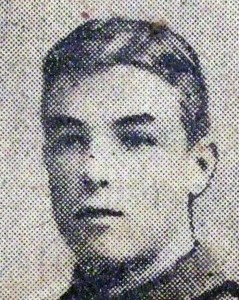
Rifleman Robert Thompson
Rifleman Thompson joined C Company, 15th (Service) Battalion, The Royal Irish Rifles (North Belfast) in 107th Brigade. Not knowing when he arrived in France, it is impossible to describe his experiences before March 1918. If he joined the Battalion in early 1917 he was fortunate indeed to survive the three major attacks by 36th (Ulster) Division that year: On 7 June at Messines the Battalion attacked in the second wave against the ‘Black Line’ and suffered 12 men killed and 93 wounded; on 16 August, during the Battle of Langemarck, 15th Royal Irish Rifles was in reserve and there were few casualties, although there had been heavy casualties in B Company caused by shellfire in the preparatory phases; during the Battle of Cambrai the Battalion was uncommitted until 22 November when it attacked the Hindenburg Support Line. This action continued until the evening of 24 November, often at close quarters against a determined enemy. The casualties were severe but are not enumerated in the Battalion’s war diary; 64 officers and men are known to have been killed in action.[4]

36th (Ulster) Division Sectors, March 1918
In 1918 Robbie Thompson found himself in a sector south-west of St Quentin near Grugies when 36th (Ulster) Division replaced French units there. By then he had been appointed a Lance Corporal in C Company. On 22 February there was a further reorganisation in the system of defence—from Blacker’s Boys:
‘…the manner in which defence was to be conducted was changed radically. Based on the German concept of ‘defence in depth’, the front was organised into three zones. The Forward Zone was essentially an outpost line in front of a line of supporting redoubts that would be held in enough strength to delay the enemy but from which its defenders would move back to the main line of defence — the Battle Zone — when attacked in strength. The Battle Zone, about two to three thousand yards back, comprised a series of well-built defence systems and redoubts that dominated the ground over which the enemy would attack. Reserves would also be available here to conduct local counter-attacks or to reinforce areas of particular threat. The third zone, the Corps Line, was to be set up in rear of the Battle Zone, but this was never achieved. The plan was a good one but, as would be proved, the troops were too thinly spread and insufficiently trained in it to make it effective.
In 36th (Ulster) Division’s area the ground was crossed by a series of ridges and valleys parallel to the front line. In the north, the outpost line lay on the same feature occupied by the enemy, and behind it lay the Grugies valley. This gave good cover from view and direct fire but provided a natural corridor along which the enemy could outflank the forward battalions. In addition, the front line of 14th (Light) Division on the right ran almost north-south, and the right flank was therefore weak and unlikely to hold if the villages of Urvillers and Essigny were captured. To the rear, the redoubts of the Forward Zone were on the next ridge, and farther back the redoubts of the Battle Zone lay on the low ridge along which ran the Essigny/Contescourt Road. The Ulster Division’s frontage was divided into three sectors, each allocated to a brigade. 108th Brigade was on the right, 107th Brigade held the centre and 109th Brigade was on the left.’
The men of 15th Royal Irish Rifles relieved 2nd Royal Irish Rifles in the Forward Zone on the night of 14/15 March. On 21 March the storm broke.
The exact dispositions of 15th Royal Irish Rifles and the detail of the action that took place on 21 March are difficult to determine—there is no official record of that period in the Battalion’s war diary.[5] The general dispositions may be deduced from the war diaries of Headquarters 107th Brigade, it’s two other battalions, the Division’s medium trench mortar batteries and 36th Battalion Machine Gun Corps (unfortunately it has not been possible to identify which company occupied each of the positions described below).
In the Forward Zone of 107th Brigade’s sector the ‘outpost line’ and the ‘line of resistance’ (see map) ran west-east, for 2,100 yards roughly along Auvergne Trench.[6] These lines, along the forward slope of a shallow ridge, were manned by two companies, with the four platoons of each company in strongpoints.[7] The role of the outpost line was to:
‘…keep the enemy’s front line, No-Man’s-Land and our own wire under constant observation by day and night from their own post to the next behind their own wire. All outposts will be wired round and alternative positions for each outpost prepared and used at different times to prevent the possibility of surprise by the enemy. The purpose of the outposts is to give warning of any enemy attack and to disorganise it in such a way as to give time to man the line of resistance. They are responsible that the post is held against small raiding parties. In the case of attack by a large force breaking through our line, they will fall back on their platoon in the line of resistance.’[8]

Positions Occupied by 15th Royal Irish Rifles on 21 March 1918
The Brigade Commander had identified four ‘points of tactical importance’. Two were in the line of resistance. The first of these was the higher ground south of Le Pire Aller on the left of the position.[9] The second was the plateau of slightly higher ground over the brigade boundary in 108th Brigade’s sector, which dominated his right flank. The platoons in the strongpoints along the line of resistance were ordered to hold ‘at all costs.’[10]
A third company was located on the reverse slop of the ridge, behind the line of resistance. It provided the ‘counter-attack company’, again with each of its platoons in strongpoints. The task of the counter-attack company ‘…in case of an enemy raid having effected a lodgement in our lines, is the immediate counter-attack by the two platoons nearest the lodgement.[11]
Behind the line of resistance was a shallow valley beyond which the ground rose again to the next line of defence. Here, one mile to the south-west of the line of resistance and 1,000 yards south of Grugies, was Racecourse Redoubt. The redoubt was centred on a fortified railway cutting—the third of the Brigade Commander’s points of tactical importance—and here were battalion headquarters, in a dugout in the cutting, and one company in the interlocking trenches of the fortified position around it.[12] The orders for those manning the redoubt were clear—they were to ‘…hold out to the last in case of a general attack in order to give time for the Battle Zone to be manned. It will on no account retire until orders are received from higher authority.’[13]
The defence of the Forward Zone was reinforced by 10 machine guns from B Company, 36th Battalion, Machine Gun Corps; two Stokes 3-inch mortars from 107th Trench Mortar Battery in the line of resistance; and two Newton 6-inch medium mortars from Y.36 Medium Trench Mortar Battery in Racecourse Redoubt.
From Blacker’s Boys:
Although there were some anticipatory British artillery barrages in the early hours, the night of 20/21 March was generally quiet. At 4.35am, however, the German offensive began with an intensive artillery barrage across the entire front. Employing guns and mortars firing high explosive, shrapnel and gas, it struck anything of importance, particularly communications, to a depth of two to four miles over a period of five hours. Between 6.00am and 9.40am the German infantry began its infiltration and advance.’
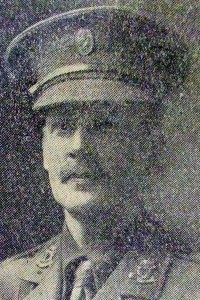
Lieutenant Colonel Claud George Cole-Hamilton CMG, DSO, KPM
The leading troops of the German 18th Army attacked 36th (Ulster) Division just after dawn. The enemy troops advanced in strength from the right flank along the valley behind the line of resistance—Lieutenant Colonel Cole-Hamilton,[14] the Commanding Officer of 15th Royal Irish Rifles wrote later; ‘…the front line was not attacked from the front at all, but from the rear.’[15] [16]
At 5.00am, after the order to ‘Man Battle Stations’ had been given, the Brigade Intelligence Officer, Lieutenant Cuming,[17] and the scouts had gone forward to Racecourse Redoubt. It was almost impossible for the companies and Battalion headquarters in the Forward Zone to convey what was happening because the heavy and well-planned artillery barrage had destroyed communications cable and telephone exchanges. Darkness at the early stages of the attack and the thick mist prevented visual signalling and the thick, foggy mist and the heavy shellfire compounded the problem for runners. Most importantly, communications between the forward battalions and their supporting artillery batteries were quickly lost.
At 8.00am Lieutenant Colonel Cole-Hamilton sent a message by a runner, who got it to brigade headquarters:
‘All communications forward and rear gone. Latest information from the line 6.45 a.m., received 7.45a.m. from Counter-attack Company says “Hostile artillery fire intense in this Sector. Casualties nil.” Very heavy shelling round redoubt. As far as known casualties 4 killed and one wounded. Fog still very thick.’[18]
At 8.20am Lieutenant Cuming sent more information, which was not received at brigade headquarters until 12.15pm, that described the enemy’s use of heavy gas and shell-fire in the morning and that the battalion headquarters of 15th Royal Irish Rifles had moved into the cutting in Racecourse Redoubt. Soon afterwards it was confirmed that the enemy was now attacking the Battle Zone. 15th Royal Irish Rifles had been cut off.
In his account about the attack at Racecourse Redoubt Lieutenant Colonel Cole-Hamilton wrote:
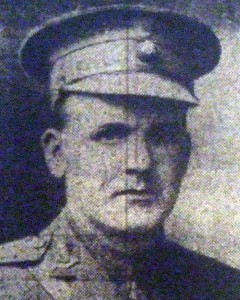
Captain John Hazelton Stewart DSO, MC
‘At about 9.30 a.m. all communications, both forward and to rear, had gone bust, so we knew nothing that was happening. At 10.15 a.m. our posts were driven in; at 10.30 a.m. fighting became heavy all round us—shortly after this, the left of the redoubt was overrun. This left us with only the portion of redoubt from Contescourt to Railway Cutting inclusive. The 2 platoons on the left had been all killed or captured also. From that or about 10.40 a.m. we had very close fighting, and were engaged by Flammenwerfer (4 attacks) knocked out finally by the Adjutant with Rifle Grenades, machine guns heavy and light, and Minenwerfers while the enemy infantry made several attacks over the open and along trenches with bombs. Every now and then, they seem to withdraw, and then we were heavily shelled – then the infantry would attack again.’[19] [20]
For his gallantry in the defence of the redoubt the Adjutant, Captain J H Stewart MC, was awarded the Distinguished Service Order.
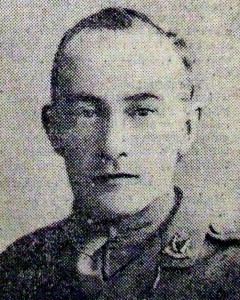
Second Lieutenant Edmund De Wind VC
The Battalion’s final stand was made in this small section of trenches between the old French trench, Contescourt Alley, and the railway cutting, which proved, indeed, to be a point of tactical importance. One of the platoon commanders in the redoubt was Second Lieutenant Edmund de Wind.[21] For some time he held out in a section of the redoubt ‘practically single-handed’ and later, with two NCOs he ‘got out on top under heavy machine-gun and rifle fire, and cleared the enemy out of the trench’.[22] It was largely through his leadership and personal bravery that the redoubt was held for so long. He was killed in the afternoon and for his gallantry was awarded a posthumous Victoria Cross.
That evening, at about 5.35pm, surrounded and with only 30 men unwounded, Lieutenant Colonel Cole-Hamilton took the decision to surrender. He wrote later:
‘It was a bitter moment, but I do not think we could have done more. The Officer in command of the Battalion who captured us told me he had taken over command as his C.O. had been killed, that a Battalion had been attacking us all day and a second had been sent up to help them or had been engaged for some time, so I think we did what we could to help the cause. I had only about 30 men left unwounded – only 60 all told were able to walk away and this included various oddments – Trench Mortar and Machine Gun Teams…’[23]
The casualties were severe and the Battalion was destroyed. Battalion headquarters, four rifle companies and the attached men of the trench mortar batteries and machine gun company had been killed or captured; many of those captured were also wounded; some of these wounded died soon after capture and were buried by the enemy. The war diary does not detail the total number of casualties but at least four officers and 70 other ranks were killed in action on 21 March or in the actions fought by the remnant of the Battalion before it was withdrawn from the line on the morning of 28 March.[24] Twenty-three men died subsequently in captivity.[25]
The war diary entry for 21/22 March recorded:
‘The diary now deals with the movements of the Battn details which consisted of Transport, personnel of Quartermaster’s Stores, personnel left out of action, other ranks arriving back from leave, from courses and from hospital together with a draft of some 100 O.R. which arrived to-day. The Battn itself was gone, killed, wounded and prisoners. Captain P.M. Miller, M.C. commanded the little party.’[26]
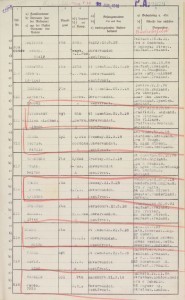
Friedrichsfeld POW Camp Register
Sometime during the fighting in the Forward Zone on 21 March, Lance Corporal Robbie Thompson was captured. There is no record of his journey into captivity but it is known that he was held at Friedrichsfeld bei Wesel prisoner of war camp north of Duisburg in the Rhineland. Friedrichsfeld was reputed to be among the better POW camps—you can read more about the camp here.
It was not until the prisoners had been repatriated in late 1918 that the full story about the gallantry of 15th Royal Irish Rifles at Racecourse Redoubt became known. The awards for gallantry for Edmund de Wind and those who had survived were published in May and October 1919 and in the ‘Prisoner of War Gazette’ in January 1920:
Victoria Cross[27]
Second Lieutenant Edmund de Wind (killed in action)
For most conspicuous bravery and self-sacrifice on the 21st March, 1918, at the Race Course Redoubt, near Grougie. For seven, hours he held this most important post, and though twice wounded and practically single-handed, he maintained his position until another section could be got to his help. On two occasions, with two N.C.O.s only, he got out on top under heavy machine-gun and rifle fire, and cleared the enemy out of the trench, killing many. He continued to repel attack after attack until he was mortally wounded and collapsed. His valour, self-sacrifice and example were of the highest order.
Bar to the Distinguished Service Order[28]
Lieutenant Colonel Claud George Cole-Hamilton CMG, DSO (Commanding Officer, captured)
Distinguished Service Order[29]
Captain John Hazelton Stewart MC (Adjutant, captured)
Bar to the Military Cross[30]
Captain James Edmund Smith Condon MC (OC D Company, captured)
Military Cross[31]
Lieutenant Robert Sprott (captured)
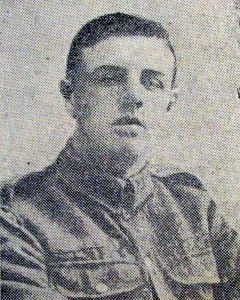
Sergeant Samuel Getgood DCM
Distinguished Conduct Medal[32]
15/1044 Sergeant Samuel Getgood (captured)
15/12170 Lance Corporal Charles Hubert Walker MM (captured & wounded)
Military Medal[33]
15/43219 Company Quartermaster Sergeant Harry Frank Beaconsfield Harris
17/878 Rifleman (Acting Lance Sergeant) John McClure Bill
41287 Lance Corporal Henry Collop
608180 Rifleman William Frank Davis
15357 Rifleman Thomas McClatchey
24033 Rifleman Frank James Price
10/16087 Rifleman Robert Watters
4434 Rifleman John Campbell (captured)[34]
Mention in Despatches[35]
Reverend William Frederick Morris MC, Army Chaplains Department (captured)
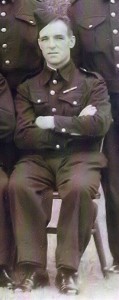
Private Robert Thompson, Ulster Home Guard
Robbie Thompson was repatriated to the United Kingdom in November 1918 and he returned to Hyde Park, where he went back to work in the local mill. On 12 June 1930 he married Emma McMullan Greer at Hyde Park Presbyterian Church. During the Second World War he served with the Ulster Home Guard. Robbie Thompson died at Hyde Park on 12 April 1969, aged 70, and is buried in Mallusk Cemetery.


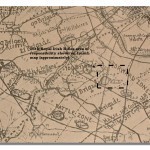
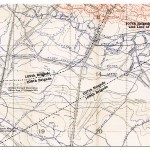
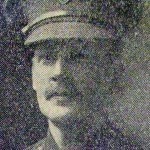
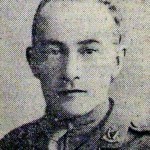
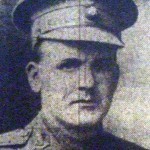
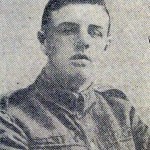
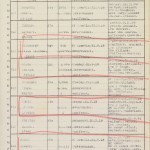
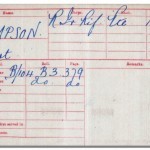
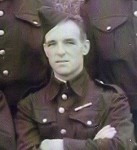

Acknowledgement:
Nigel Henderson for the photographs from the Belfast Evening Telegraph.
1. (Back) Henry Thompson (born 21 July 1875) married Margaret White (born 20 September 1875) on 7 April 1898 at Carnmoney Parish Church. They had twelve children: Robert (born 25 December 1898), John (born 1 January 1900), Samuel, my grandfather, (born 28 May 1902), Ellen ‘Nellie’ (born 30 July 1903), Jane ‘Jeanie’ (born 15 September 1905), William (born 14 September 1907), Henry ‘Harry’ (born 29 June 1909), James (born 8 May 1911), Sarah Evelyn ‘Effie’ (born 2 July 1913), Margaret (born 23 June 1915), Emma (born 21 March 1918), and Eileen Robina ‘Ruby’ (born 12 December 1920).
2. (Back) The Royal Irish Rifles was the largest of the Irish infantry regiments; in addition to the two regular battalions, it raised 11 service battalions, a garrison battalion and nine reserve battalions. Of the nine battalions in 36th (Ulster) Division, four were raised in Belfast and formed 107th Brigade—8th (Service) Battalion (East Belfast), 9th (Service) Battalion (West Belfast), 10th (Service) Battalion (South Belfast) and 15th (Service) Battalion (North Belfast). Three were battalions of 108th Brigade—11th (Service) Battalion (South Antrim), 12th (Service) Battalion (Central Antrim), and 13th (Service) Battalion (1st County Down). One was in 109th Brigade—14th (Service) Battalion (Young Citizens); and the 16th (Service) Battalion (2nd County Down) (Pioneers) was the Division’s pioneer battalion.
3. (Back) Two reinforcement drafts, totalling 242 men, arrived in the Battalion on 7 February 1917. This is probably the earliest that he joined the Battalion.
4. (Back) This estimate is based on a study of the Commonwealth War Graves Commission records. It is a low estimate and only includes those who were specifically identified as being from 15th Royal Irish Rifles. It does not include those who later ‘died of wounds’.
5. (Back) The period from 1 to 20 March is missing from the war diary. The subsequent entries, compiled by Lieutenant Andrew Newton-Anderson, the Assistant Adjutant, dealt with the Battalion’s ‘details’, i.e. those not present with the Battalion in the line.
6. (Back) The National Archives (TNA). Public Record Office (PRO) WO95/2502-1. 107th Brigade war diary. ‘From B.8.c.90.65 on the left to B.10.c.60.40 on the right.’ (Map 66cNW1.)
7. (Back) TNA. PRO. Op. Cit. The Brigade Defensive Scheme defined each type of defensive position:
Strong Point: ‘…a defended post organized for passive defense. It may or may not be wired all round. Its normal garrison is one platoon.’
Keep: ‘…a defended post wired all round, provided with rations water, ammunition and bombs for 48 hours and organized for protracted and passive defence. Its normal garrison is one platoon.’
Redoubt: ‘…a glorified keep whose normal garrison is one company.’
8. (Back) TNA. PRO. Op. Cit.
9. (Back) Le Pire Aller is now the junction of the D1 and D321 south-east of Gauchy.
10. (Back) TNA. PRO. Op. Cit.
11. (Back) Ibid.
12. (Back) Author’s note—I believe this to be D Company.
13. (Back) Ibid.
14. (Back) Lieutenant Colonel Claude George Cole-Hamilton (KStJ), CMG, DSO, KPM was born on 27 January 1869 at Killeshandra, County Cavan. He was commissioned into the 5th Battalion (Royal South Down Militia), The Royal Irish Rifles on 28 February 1900, promoted to Lieutenant on 18 October 1900 and to Captain on 31 March 1901. He volunteered for service in the South Africa War, where he commanded a mounted infantry company—he was mentioned in despatches (London Gazette 29 July 1902. Issue 27459, p 4851.) and made a Companion of the Distinguished Service Order (London Gazette 31 October 1902 Issue 27490, p 6906.) ‘In recognition of services during the operations in South Africa’. On his return from South Africa he served with the 6th Battalion (Louth Militia) until it was disbanded in 1907. He then served with the 4th Battalion (Special Reserve) until he resigned his commission on 5 October 1912. On 9 February 1915 he was appointed Second-in-Command of 12th (Service) Battalion (Central Antrim) in 108th Brigade, 36th (Ulster) Division. He was promoted to Temporary Lieutenant Colonel on 3 August 1915, to command 8th Royal Irish Rifles in 107th Brigade and was appointed to command 15th Royal Irish Rifles on 9 September 1917. He was wounded in 1916 and in 1917 before being wounded, gassed and captured on 21 March 1918. For his wartime service he was thrice mentioned in despatches (London Gazette 25 May 1917. Issue 30093, p 5156; 24 May 1918. Issue 30701, p 6101; and 9 July 1919. Issue 31442, p 8708.), was made a Commander of the Order of St Michael and St George (London Gazette 4 June 1917. Issue 30111, p 5459.), and earned a Bar to his DSO (London Gazette 30 January 1920. Issue 31759, p 1218.). He was repatriated from Germany on 14 December 1918. He subsequently served as the Chief Constable of Breconshire, for which he was awarded the King’s Police Medal (London Gazette 1 January 1936. Issue 34238, p 17.) He was appointed a Knight of the Venerable Order of the Hospital of St John of Jerusalem in 1943 (London Gazette 21 June 1943. Issue 36069, p 2897.) He died on 6 January 1957, aged 87.
15. (Back) Public Record Office Northern Ireland (PRONI). D961 – Newton and Anderson papers. Lieutenant Colonel Cole-Hamilton’s account of the actions of 15th Royal Irish Rifles on 21 March 1918, written on 31 March 1918 while he was a prisoner of war.
16. (Back) The narrative in the war diary of the Divisional Trench Mortar Batteries also recorded that the ‘Centre Strong Point at Grugies was attacked in the rear…’ See TNA. PRO. WO95/2496-7.
17. (Back) Captain Arthur Eric MacMorrough Cuming MC, Princess Victoria’s (Royal Irish Fusiliers). He was awarded the Military Cross for his gallantry as 107th Brigade Intelligence Officer during the retreat from St Quentin. He was wounded on 21 October 1918 while serving with 1st Royal Irish Fusiliers and died of wounds on 26 October. He is buried in Terlincthun British Cemetery.
18. (Back) TNA. PRO. WO95/2502-1. Op. Cit.
19. (Back) PRONI Op. Cit.
20. (Back) Note: the left of the redoubt was to the north and north-west. Flammenwerfer – flamethrowers, Minenwerfer – trench mortars.
21. (Back) Second Lieutenant Edward de Wind was born on 11 December 1883 at Comber, County Down. He departed for Canada on 1 November 1911, where he worked in Edmonton for the Canadian Imperial Bank of Commerce. He enlisted into the Militia and served briefly with The Queen’s Own Rifles of Canada, before enlisting for service with the Canadian Expeditionary Force on 16 November 1914. He served with the 31st Battalion, Canadian Infantry in France from September 1915 before joining an officer cadet battalion in April 1917; he was commissioned into The Royal Irish Rifles on 26 September 1917. He joined 15th Royal Irish Rifles as a platoon commander in late-1917. He has no known grave and is commemorated on the Pozières Memorial. He is also commemorated on Comber War Memorial; his name is carved on a stone at the foot of a pillar at the west front of St Anne’s Cathedral in Belfast; he is named on two plaques in St Mary’s Parish Church, Comber; De Wind Drive, Comber is named after him as is Mount de Wind at the head of the Little Berland River, Willmore Park, Alberta. An Ulster History Circle Blue Plaque was unveiled in Comber in 2007.
22. (Back) Author’s note—I believe the NCOs were Sergeant S Getgood and Lance Corporal C H Walker MM.
23. (Back) PRONI Op. Cit.
24. (Back) This estimate is based on a study of the Commonwealth War Graves Commission records and I believe it to be accurate but it does not include those of the remnant of the Battalion that escaped on 21 March 1918 and who may have been wounded later and ‘died of wounds’ in hospitals in France or the United Kingdom.
25. (Back) Captured on 21 March 1918:
903 Rifleman William Agnew, died on 5 August 1918. Berlin South-Western Cemetery.
17/147 Rifleman William Walter Browne, died on 21 June 1918. Sarralbe Military Cemetery.
44818 Rifleman William Burrell, died on 21 November 1918. Selestat (Schlestadt) Communal Cemetery.
8/12665 Lance Corporal Ernest Edward Chubb, died on 12 April 1918. Niederzwehren Cemetery.
14/6615 Rifleman James Dooley, died on 28 June 1918. Berlin South-Western Cemetery.
12795 Rifleman Alexander Gillespie, died on 6 June 1918. Ham British Cemetery.
18/422 Lance Serjeant James Glenholmes, died on 20 September 1918. Niederzwehren Cemetery.
9/2635 Corporal Samuel Gribben, died on 26 October 1918. Berlin South-Western Cemetery.
44870 Rifleman Victor Ralph Howkins, died on 28 July 1918. Sarralbe Military Cemetery.
10/4311 Rifleman William McCullough, died on 1 May 1918. Cologne Southern Cemetery.
17/2247 Rifleman Ashley Albert Milne, died on 19 July 1918. Berlin South-Western Cemetery.
15656 Lance Corporal William Andrew Murdock, died on 20 July 1918. Berlin South-Western Cemetery.
43541 Rifleman William Thomas Page, died on 16 May 1918. Berlin South-Western Cemetery.
41200 Rifleman William Gregor Pigott, died on 21 September 1918. Veldwezelt Communal Cemetery.
13457 Rifleman Joseph Roy, died on 25 June 1918. Sarralbe Military Cemetery.
907 Rifleman Kennedy Scott, died on 6 June 1918. Roye New British Cemetery.
44360 Rifleman Lionel George Short, died on 31 May 1918. Avesnes-Sur-Helpe Communal Cemetery.
20/86 Rifleman Christopher Simpson, died on 24 October 1918. Berlin South-Western Cemetery.
13678 Serjeant Robert Swann, died on 12 April 1918. Sains-Du-Nord Communal Cemetery.
9/44895 Rifleman George Daniel Taylor, died on 22 June 1918. Berlin South-Western Cemetery.
15/3494 Rifleman George Tully, died on 25 August 1918. Hautmont Communal Cemetery.
Captured on 23 March 1918:
S/11695 Rifleman Archibald Larmour, died on 6 June 1918. Ham British Cemetery.
Captured on 27 March 1918:
47120 Rifleman Harry Treloggen, died on 1 July 1918. Berlin South-Western Cemetery.
26. (Back) TNA. PRO. WO95/2502-1. Op. Cit.
27. (Back) London Gazette 15 May 1919. Issue 31340, p 6084.
28. (Back) London Gazette 30 January 1920. Issue 31759, p 1218.
29. (Back) London Gazette 30 January 1920. Issue 31759, p 1218. (His first Military Cross had been awarded for his gallantry in 1917. London Gazette 1 January 1918. Issue 30450, p 47.
30. (Back) London Gazette 30 January 1920. Issue 31759, p 1218. (His first Military Cross had been awarded for his gallantry as Officer Commanding D Company during the Battle of Cambrai. London Gazette 22 July 1918. Issue 13292, p 2533.)
31. (Back) London Gazette 30 January 1920. Issue 31759, p 1220.
32. (Back) London Gazette 30 January 1920. Issue 31759, p 1221.
33. (Back) London Gazette 20 October 1919. Issue 31608, p 12874.
34. (Back) London Gazette 11 February 1920. Issue 31775, p 1784.
35. (Back) London Gazette 30 January 1920. Issue 31759, p 1224.
December 1, 2014
My Family in the First World War – Part 3: Thomas Bunting
17/673 Lance Corporal Thomas George Bunting

Thiepval Memorial
Thomas George Bunting was the nephew of William Neill and Hammie Neill. Their sister, Annie, married Matthew Bunting on 11 July 1895 at Magheralin Parish Church and the couple had three children—Miriam, born on 31 October 1895, Thomas George born on 25 February 1897, and Alfred born on 19 June 1903. Annie, Matthew and the two boys lived in a small, three-roomed house in Ballymacateer and Miriam lived with her grandparents nearby. It is not known where Thomas worked before the war but it was probably in the mill with his parents and uncles.
Thomas Bunting enlisted into The Royal Irish Rifles on, or about, 17 May 1915, aged 18, and joined the 17th (Reserve) Battalion at Newcastle, County Down, where he was allocated the number 17/673.
The 17th (Reserve) Battalion had been formed in May 1915 from the depot companies of the 8th, 9th and 10th (Service) Battalions as those battalions prepared for their departure for England with the Ulster Division. It was responsible for training the reinforcements for those battalions and it did so until the reorganisation of the reserve battalions and their move to England in April 1918.
Like many who had enlisted just before the Ulster Division left for Seaford, Thomas Bunting’s training was completed in time for him to join a battalion of 36th (Ulster) Division before it sailed for France.
The 9th (Service) Battalion, The Royal Irish Rifles (West Belfast) had been raised in September 1914, largely from men of the Ulster Volunteers. One of four battalions in 107th Brigade, it trained at Ballykinler until 36th (Ulster) Division moved to Seaford on the Sussex coast in the first days of July 1915. Rifleman[1] Thomas Bunting joined 9th Royal Irish Rifles at some time in the late summer of 1915. The final period of musketry training took place at Bramshott and it was from here on 3 October that the Battalion set off by train for Folkestone and sailed for France. Thomas Bunting landed in Boulogne-sur-Mer later that evening. The next day he travelled by train to Flesselles and marched to billets at Vignacourt. Over the next few days he marched closer to the front line. Finally, on 10 October, he arrived at Hédauville and in a tented camp there he prepared for his first stint in the trenches.
It was customary for New Army units to undergo training with more experienced formations. 107th Brigade was the first of the Ulster Division’s three brigades to be detached—it joined 4th Division, a regular division and part of the original British Expeditionary Force that had landed in France in August 1914.[2] The 4th Division was in the line north of the River Ancre opposite Beaumont Hamel. The first to experience life in the forward trenches were the men of C and D Companies, who marched up to the line and were attached, respectively, to 1st Battalion, The Hampshire Regiment and 1st Battalion, The Rifle Brigade (The Prince Consort’s Own) in 11th Brigade. Their early experience was not a quiet one—C Company was subject to an artillery and mortar barrage the following morning and the Battalion suffered its first casualties when a shell hit a dugout ‘packed with men’: two men of 1 Hants were killed and one NCO and four men of 9th Royal Irish Rifles were wounded. Two days later a German patrol surprised a patrol from C Company—the war diary reported that one man had been wounded and captured and another man wounded. In fact, Rifleman John Hanna died of his wounds; the enemy buried him behind their lines at Miraumont.[3] D Company, meanwhile, had suffered no casualties before the two companies were withdrawn and replaced by A and B Companies. They were attached to 1st Battalion, The East Lancashire Regiment and 1st Battalion, Prince Albert’s (Somerset Light Infantry) respectively. They suffered a total of three men wounded (one accidentally) before they were withdrawn on the night of 17 October. For the rest of the month Thomas Bunting and the men of the 9th Royal Irish Rifles were out of the line engaged in further training.
Once their familiarisation training was completed, New Army and Territorial Force divisions new to France and Flanders exchanged a third of their battalions for regular, experienced battalions and on 4 November 107th Brigade was exchanged for 12th Brigade, 4th Division. As a result, Thomas Bunting spent the next three months in 4th Division, and he would have noticed that his Brigade had been somewhat reorganised, losing two battalions and gaining two regular English battalions and a regular Irish Battalion.[4] The first two months were relatively quiet in most of the sector occupied by 107th Brigade but the weather was terrible and the trenches were in poor condition. This period was not wholly without incident. The Battalion witnessed its first fatal casualty (it is unlikely anyone would have known the earlier fate of John Hanna) when Rifleman Daniel Crilly, aged 37, of B Company, was shot by a sniper on 8 December.[5] In all, by the end of the year two men had been killed, 21 wounded and seven captured (all of whom were also wounded).
In January 107th Brigade took over the southern sector of the 4th Division’s area of responsibility. Here life was harder for the men of 9th Royal Irish Rifles and fatal casualties increased, primarily because this sector included ‘Mary Redan’—a salient of trenches west of Beaumont Hamel and close to the German line (see map). In his history of 36th (Ulster) Division, Cyril Falls describes the Redan as:
‘…a most unpleasant corner. In the first place, it was not more than fifty yards from the German lines, and the mine-craters which fringed its eastern edge, which were occupied at night by British posts—a doubtful policy, as it appears today—were in constant danger of surprise. …one post was indeed bombed by the enemy and a man taken out of it. In the second place, the Redan was the scene of constant mining, and the bugbear of battalions in reserve, which had to send up large working parties to carry sandbags filled with chalk for the miners. It was the one point in our trenches which received fairly constant attention from German gunners, and the average weekly casualties in this tiny lozenge were probably higher than on the whole of the rest of 4th Division’s front.’[6]

Mary Redan and Beaumont Hamel
The difficulty of the fighting in this small area early in 1916 is reflected in 9th Royal Irish Rifles being mentioned by name in the dispatch of 29 May by the Commander-in-Chief, General Sir Douglas Haig:
‘While many other units have done excellent work during the period under review, the following have been specially brought to my notice for good work in carrying out or repelling local attacks and raids.’[7]
107th Brigade rejoined 36th (Ulster) Division on 7 February 1916, when the Ulster Division took over a sector of the front with its original brigades and battalions for the first time—107th Brigade remained on the left of the Divisional front and continued to hold Mary Redan.
Later that month, Thomas Bunting and his fellow soldiers of 9th Royal Irish Rifles witnessed the death of one of their own but not through enemy action.
In the early afternoon of 31 January the Battalion had paraded at Varennes in preparation for moving into the line at Mary Redan and the trenches immediately to its left. The relief was complete at about 7.00pm and at 8.45pm Corporal Todd[8] went to look for Rifleman James Crozier to ‘warn him for sentry duty at 9.00pm’.[9] Crozier was nowhere to be found. Corporal Todd reported his absence to Company Sergeant Major Hill[10] and another search failed to find him. Four days later, on the morning of 4 February, while the Battalion was still in the line, he was found by Corporal William Taylor[11] at 7th Ammunition Sub Park, some 25 miles in the rear, without his rifle or equipment, and was placed in custody. The next day he was collected by Corporal Fred Brightmore[12] of 4th Division Military Mounted Police and taken to Headquarters 36th (Ulster) Division.
Rifleman Crozier was charged with
‘…deserting His Majesty’s Service in that he ‘In the Trenches’ on the 31st January 1916 absented himself from 9th Battalion, Royal Irish Rifles until apprehended ‘In the Field’ by Corporal William Taylor on the 4th February 1916.’[13]
At his court martial on 14 February, Crozier’s defence was that he was sick and could not remember leaving the trenches. He was found guilty and sentenced to death. It seems clear that the strong recommendation from his commanding officer and brigade commander that the execution should be carried out meant that there was little chance that Crozier’s sentence would be commuted.[14]
He was executed by a firing squad within earshot of the parading Battalion at 7.05am on 27 February 1916.[15]
In March a reorganisation occurred that left 36th (Ulster) Division responsible for a sector astride the River Ancre (see map). This comprised two sub-sectors—Thiepval Wood on the right of the river and Hamel on the left—and it was here that the Ulster Division would face its first major trial.

Thiepval and Hamel Sub-Sectors, 1916
On 30 March, 9th Royal Irish Rifles moved into billets in Puchevillers, 11 miles to the west of Thiepval Wood. Preparations for the forthcoming attack were well under way and for the next three weeks Thomas Bunting and his comrades spent their time on work parties on the railroad that ran alongside the River Ancre, and engaged on company-level training. The last week of the month and the first week of May was spent in billets in Forceville, training at company-level and conducting mock attacks over dummy trenches. On 9 May, Thomas marched to Martinsart and for the next three weeks he was sent forward to Thiepval Wood on work parties.
Finally, on 30 May, he went into the trenches in Thiepval Wood. 107th Brigade was to be in reserve for the imminent attack, and the Brigade took over the front-line trenches in both sectors. This allowed the men of 108th and 109th Brigades to move into reserve and prepare for their part in the attack. The men of 9th Royal Irish Rifles spent the next week here, which was quiet until 5 June. That night, a raid took place in the Hamel sub-sector and, in response to the supporting artillery barrage, the enemy shelled heavily the area occupied by C Company on the left of Thiepval Wood; seven men were killed and 29 wounded.
Having been relieved by 8th Royal Irish Rifles on 6 June, the Battalion spent the next week on work parties in the wood before returning to the front line trenches on 13 June. Relieved again by 8th Royal Irish Rifles on 20 June, the men endured two more days of work parties before beginning a final period of training and practice attacks.
From Blacker’s Boys:
The front for which 36th (Ulster) Division was responsible was divided into four sectors, to be attacked by 108th and 109th Brigades, with 107th Brigade in reserve. The right and right-centre sectors ran north and north-east from Thiepval Wood and were the responsibility of 109th Brigade. For this it was reinforced by 11th and 13th Royal Irish Rifles from 108th Brigade and 15th Royal Irish Rifles from 107th Brigade. The left-centre sector, immediately east of the River Ancre and including the area around St Pierre Divion, was not to be attacked directly. The left sector (previously the Hamel sub-sector) would be attacked by the remaining two battalions of 108th Brigade—12th Royal Irish Rifles and 9th Royal Irish Fusiliers. The attacking Brigades were tasked with clearing the enemy’s first, second and third lines before 107th Brigade captured the enemy’s fourth line, the Division’s final objective. All of the strong-points to be captured by the Division were named after well-known towns in Ulster. In the German ‘A Line’ there was Kilrea, Lisburn, Cavan and Moy. In the ‘B Line’ were Gobbins, Larne, Bushmills, Lurgan, Clones and Dungannon. Farther back in the ‘C Line’ were Coleraine, Portadown, Enniskillen, Strabane, Omagh and Lisnaskea. Finally in the D Line, and the final objectives, were Portrush, Bundoran and Derry City.
The artillery provided for the Division’s action was enormous. In addition to its own batteries, a brigade of four batteries was attached from 49th Division and a regiment from the French. The preliminary bombardment was to last for five days from 24 to 28 June, designated ‘ U Day’ to ‘ Y Day’, and was aimed at cutting the enemy wire and destroying the front line trenches. The barrage during the attack itself on ‘ Z Day’ would not be a true creeping barrage, but after a final intensive bombardment of sixty-five minutes it would fire upon each German line in succession.
The bombardment of the German trenches began as planned on 24 June. 9th Royal Irish Rifles was now in Léalvillers, seven miles west of Thiepval Wood and it was here that it continued to train for the first four days of the massive bombardment. On 27 June Thomas Bunting marched to Forceville, two miles closer to the front and on 28 June he marched to the assembly trench at Aveluy Wood but orders were issued postponing ‘Zero Hour’ for 48 hours and at 7.00pm the Battalion paraded and Thomas marched back to Léalvillers.
On the evening of 30 June he marched forward again to the assembly trench at Aveluy Wood, in preparation for the attack the following morning. By 4.00am 107th Brigade was in position with 8th, 9th and 10th Royal Irish Rifles in the north portion of Aveluy Wood (15th Royal Irish Rifles was in the western portion of Thiepval Wood under command 108th Brigade). Thomas spent a restless night here unable to hear much more than the noise of the final hours of the bombardment.
From Blacker’s Boys:
Saturday 1 July dawned clear and dry and the Ulster Division attacked on time as ordered against the formidable defences on the Thiepval plateau. Beyond the first line trenches was the strongly built Swaben Redoubt, overlooked by Thiepval Village on the right and by the villages west and north of the River Ancre on the left. Having swept through the first line trenches there was bitter fighting for the Redoubt that involved most of the attacking battalions. The Redoubt was entered at 8.00am and, despite heavy losses, was taken by 8.30am. At about 9.15am 107th Brigade passed through the forward units of the two leading Brigades and advanced on the next objective in front of Grandcourt. Many casualties were taken but the position was entered and captured. Sadly, the effort and courage of the attacking troops was in vain; with no protection on the flanks, where the attacks by 29th and 32nd Divisions had failed, the leading troops were forced back to the Swaben Redoubt that afternoon. Delays in sending up reinforcements, the domination of the ground by German machine gunners, and repeated counter-attacks eventually forced the decision that the remnants of the Ulster Division must retire to the German front line. This was carried out in good order at 10.00pm after nearly fourteen hours of fighting, and during the night most of the survivors were withdrawn farther to Thiepval Wood, although small groups remained within the German lines.
By dawn on 2 July it had become clear that groups of men were holding out in the A and B Lines. Headquarters 36th (Ulster) Division ordered that ‘…they must be supported and reinforcements sent. Bombs and S.A.A. to be sent up to them and the position they hold to be consolidated and the flanks strongly held by blocking parties.’[16]
Lieutenant Colonel Crozier was ordered to reinforce the trenches from A15 to A19 and a composite battalion was formed from 100 men each from 8th, 9th , & 15th Royal Irish Rifles and 60 men from 10th Royal Irish Rifles. Crozier had intended to lead this operation himself but he was stopped by the commander of 107th Brigade and command devolved to Major P J Woods.[17] Although this composite battalion lost about a third of its strength crossing from Thiepval Wood to its objective, it was successful in reinforcing the new front line. Another day was spent in close proximity to the counter-attacking enemy before these men were finally relived at 10.40am on 3 July and returned to Thiepval Wood, bringing back 15 prisoners. The remnants of 107th Brigade then marched to Martinsart.
Lance Corporal Thomas Bunting was killed in action sometime over the period 1 – 3 July; he was only 19 years old. Like the majority of casualties from the 36th (Ulster) Division’s attack, his death is recorded as having being on 1 July. It is not known where he is buried and he is commemorated on the Thiepval Memorial.[18]
(A detailed description of the attack by 9th Royal Irish Rifles will be published here in mid-2015.)

Thomas Bunting on Thiepval Memorial
He is also commemorated on the Dollingstown war memorial. This simple memorial , on the Belfast Road alongside Alfred Terrace, is in the form of an obelisk. It was designed by the German-born, London-based architect Maximilian Clarke and was dedicated in February 1921. It commemorates 20 men from Dollingstown and Ballymacateer who were killed in the First World War and six men killed in the Second World War. Also commemorated is Robert McDowell, a former soldier of 16th Royal Irish Rifles and member of the Ulster Special Constabulary, who was murdered near Greystones, County Wicklow on 22 June 1922. Those from Dollingstown and Ballymacateer who served during the First World War and who returned home are commemorated on the Roll of Honour; included on it are William and Hamilton Neill.
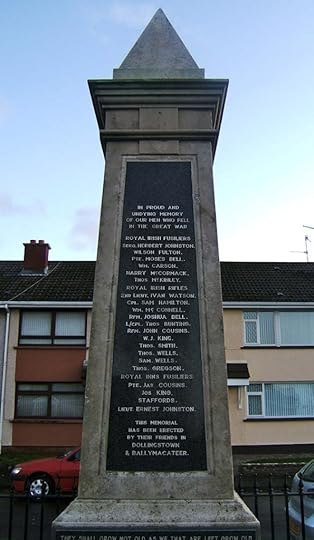
Dollingstown War Memorial
The wartime death of Thomas Bunting was not the only tragedy to befall the family—his brother Alfred drowned while swimming in the River Lagan near Magheralin on 4 July 1921, aged 18.
Miriam had married Samuel Gardiner, a widower who worked as a carpenter in Dollingstown, on 4 May 1921 at Magheralin Parish Church.[19] Samuel Gardiner had served with the 8th (Service) Battalion, The Royal Irish Rifles (East Belfast) (8/11671, Sergeant) from its arrival in France in 107th Brigade, 36th (Ulster) Division. He finished the war as a Sergeant in the 1st Battalion. Samuel Gardiner had four sons (and a daughter who died at birth) with his first wife; it was the birth of a sixth child that resulted in her death in 1918. One of his sons, Norman, married my great-aunt May Neill, the daughter of William Neill. Miriam and Samuel Gardiner had two sons, Alfred (Alfie) and William (Billy). Alfie’s son, Gerald Gardiner, was murdered by the Provisional IRA in 1976.
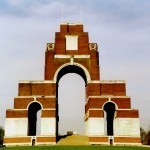
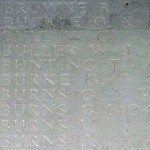
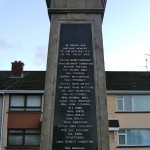
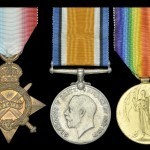
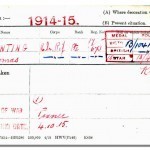
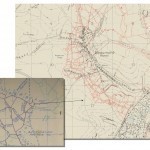
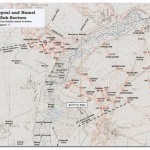
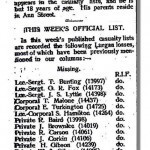
Acknowledgements:
My cousin, Gillian, for the image of Thomas Bunting’s name on the Thiepval Memorial and the newspaper extract.
Diane Flanagan for the photo of Dollingstown war memorial.
1. (Back) The rank ‘Rifleman’, although commonly used to describe a private soldier in The Royal Irish Rifles, was not adopted officially until 1923. As a consequence records show men of the Regiment variously as ‘Rifleman’ and ‘Private’. For consistency and in keeping with the custom within the Regiment, the rank ‘Rifleman’ is used throughout.
2. (Back) 107th Brigade was not well regarded by Major General Nugent, commanding 36th (Ulster) Division. He considered it less disciplined than the other two brigades in the Division, and he believed that some of its senior officers were not up to the mark. This poor reputation was not to last.
3. (Back) The graves of Rifleman John Hanna and of five other men buried in Miraumont German Cemetery were destroyed by shellfire. He is commemorated on a special memorial in Queens Cemetery, Bucquoy.
4. (Back) In this reorganisation, 8th Royal Irish Rifles joined 10th Brigade, 15th Royal Irish Rifles joined 11th Brigade and 107th Brigade received, 1st Battalion, Princess Victoria’s (Royal Irish Fusiliers), 1st Battalion, The Rifle Brigade (The Prince Consort’s Own) and 1/2nd Battalion, The Monmouthshire Regiment.
5. (Back) 17/294 Rifleman Daniel Crilly was buried in Sucrerie Military Cemetery, Colincamps, Plot II, Row E, Grave 4.
6. (Back) Falls, C. (1922). The History of the 36th (Ulster) Division. Belfast: McCaw, Stevenson & Orr.
7. (Back) London Gazette. (29 May 1916). Issue 29599, p 5311.
8. (Back) 9/18835 Corporal Edward Todd, 9th Royal Irish Rifles. Discharged on 8 July 1918 as a result of wounds.
9. (Back) For a full account of the trial proceedings see: The National Archives (TNA): WO 71/450.
10. (Back) 9/16552 Company Sergeant Major Arthur Hill, 9th Royal Irish Rifles.
11. (Back) MS/3292 Corporal William Taylor, Army Service Corps.
12. (Back) P1172 Corporal Fred Stanley Brightmore, Military Mounted Police (formerly 4958, Private, The Rifle Brigade (The Prince Consort’s Own)). Discharged on 23 October 1916 as a result of illness.
13. (Back) TNA. Op. Cit.
14. (Back) TNA. Op. Cit.
The Commanding Officer, Lieutenant Colonel F P Crozier, wrote:
‘From a fighting point of view this soldier is of no value. His behaviour has been that of a ‘shirker’ for the past 3 months. He has been with the Expeditionary Force in France since 3.10.15.
I am firmly of the opinion that the crime was deliberately committed with the intention of avoiding duty on the Redan, more particularly as he absented himself shortly after the case of another soldier had been promulgated for a similar crime. The Officer commanding the man’s Company is of the same opinion. Sentence was remitted in the case mentioned to 2 years Hard Labour.’
The Brigade Commander wrote:
‘I recommend that the extreme penalty in the case of No.9/14218 Rifleman James Crozier be carried out.
My reasons for this recommendation are that the case is one of deliberately avoiding duty in the trenches and as a deterrent to a repetition of offences of this nature. The discipline of the 9th. R. I. Rifs. is good for a Service Battalion.’
15. (Back) 9/14218 Rifleman James Crozier is buried at Sucrerie Military Cemetery, Colincamps, Plot I, Row A, Grave 5.
16. (Back) War Diary, 107th Brigade.
17. (Back) Colonel Philip James Woods CMG, DSO. Philip James Woods was born on 23 September 1880. He served in the South African War with the South African Constabulary. On his return he worked in the linen industry. During the Home Rule crisis he was a member of the Ulster Volunteer Force in Belfast. He was commissioned into The Royal Irish Rifles on 10 September 1914. For his conduct during the operations from 1 to 3 July 1916, he was mentioned in despatches (published on 4 January 1917) and made a Companion of the Distinguished Service Order (DSO) (1 January 1917). He commanded the 9th Royal Irish Rifles from January 1917 until 2 August 1917, when he was replaced in command. He commanded the 19th (Reserve) Battalion until the reorganisation of the Ulster Division’s reserve battalions in April 1918. In May 1918 he joined the forces taking part in the Allied intervention in Russia, specifically in East Karelia, where he commanded a Karelian regiment. He was appointed Companion of the Order of St Michael & St George (CMG) (Lieutenant Colonel) for services in North Russia on 1 January 1919. Following the murder of William Twaddell MP he was elected Member of Parliament for West Belfast in 1923. He was defeated in the 1929 general election. He died on 12 September 1961.
18. (Back) Thiepval Memorial , Pier and Face 15 A and 15 B.
19. (Back) His first wife, Eliza Jane McClean, died on 25 April 1918 in childbirth. They had married on 25 September 1903 at Magheralin Parish Church and had five other children: Joseph, born on 12 December 1903; Samuel, born on 11 June 1905; Thomas George, born on 5 May 1908; a daughter who died at birth on 27 December 1910; and Norman, born on 23 August 1912.
Back to My Family in the First World War.
November 26, 2014
Arlington National Cemetery – LCDR ‘Jack’ Doherty, USN (Ret)
Yesterday, I had the privilege to attend the funeral at Arlington National Cemetery of my next door neighbour, Jack Doherty.

Arlington National Cemetery
Jack was born in Malden Massachusetts on 6 February 1924. He enlisted into the United States Navy in March 1942, aged 18, and during the Second World War he served in the north Atlantic in USS Natchez, a patrol frigate. This was the first of three wars that he experienced first-hand; he also served in Korea and Vietnam. That service earned him three awards of the Combat Action Ribbon, the Korean Service Medal, with two service stars, and the Vietnam Service Medal, also with two service stars. In addition to the USS Natchez, his sea time was spent in the destroyer USS Robert A. Owens, the amphibious assault ship USS Guadalcanal, the communications relay ship (a converted escort carrier) USS Annapolis, and USS Okanogan, an attack transport. Jack retired after 27 years’ service in December 1969. He had married Lillie in 1948.

The cortege of LCDR John T. ‘Jack’ Doherty, USN (Ret)
Jack was accorded full military honours. The cool, autumn morning began with a short Mass at the Old Post Chapel in Fort Myer before Jack’s flag-covered casket was placed onto the caisson by eight Navy pallbearers, all of whom were junior enlisted Sailors. The horse-drawn caisson is the responsibility of the Unites States Army Caisson Platoon, from the 3rd United States Infantry Regiment based at Fort Myer; the squad on duty was first class. The cortege was led by the ceremonial unit of the United States Navy Band, the colour party and an escort platoon and, at a brisk pace, with appropriately ‘brisk’ music, it marched almost 2½ miles through the cemetery to the burial site. A short prayer was followed by three rifle volleys, ‘Taps’—played perfectly—and the presentation to Lillie of the immaculately folded flag from his casket. It was an impressive farewell.
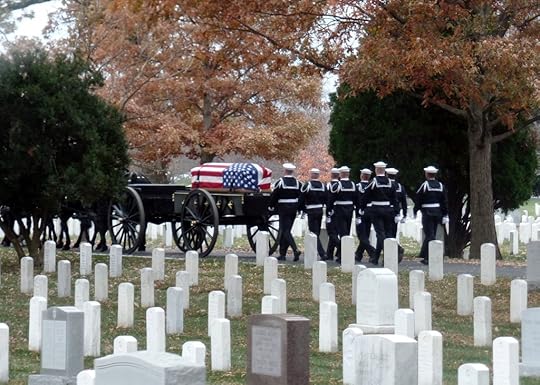
The caisson carrying the casket of LCDR John T. ‘Jack’ Doherty, USN (Ret)
Arlington National Cemetery is a credit to the United States and to those who maintain its traditions. It is immense—it covers 624 acres and, since the first burial on 13 May 1864, over 400,000 people have been interred amongst its gently rolling hills. There is much to be seen, from the Tomb of the Unknown Soldier at the impressive Memorial Amphitheater; to monuments commemorating the Civil War (the Confederate memorial is particularly impressive) and most of the wars since; monuments to the dead from Operation EAGLE CLAW—the failed Iran rescue operation—and those killed in the space shuttle tragedies.
The day prior to Jack’s funeral, I found the 12 graves of those who died during the First World War and which are maintained by the Commonwealth War Graves Commission—a commemorative piece on each of these men will be posted here.

Field Marshal Sir John Dill GCB, CMG, DSO
These are not the only Empire or Commonwealth commemorations. There are twenty burials from the Second World War. Amongst them is that of Field Marshall Sir John Dill, Chief of the British Joint Staff Mission—over his grave on Roosevelt Drive is an imposing statue of him and, nearby, the citations of the joint resolution of appreciation passed by Congress and of a posthumous award of the Distinguished Service Medal. Near the Memorial Amphitheater, and unique in the United States, is a Cross of Sacrifice. It was proposed by the Canadian Prime Minister in 1925 to commemorate ‘Citizens of the United States who served in the Canadian Army and gave their lives in the Great War’ and was dedicated in 1927. Similar inscriptions were added after the Second World War and the Korean War.

The Canadian Cross of Sacrifice at Arlington National Cemetery
It is hard to imagine a more perfect commemoration of a nation’s servicemen and women than Arlington National Cemetery.
Lieutenant Commander John Thomas ‘Jack’ Doherty, United States Navy (Retired)
1924 – 2014
requiescat in pace
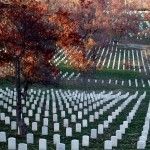
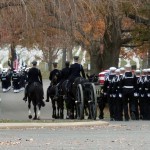
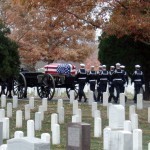
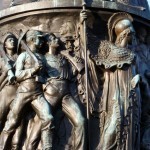
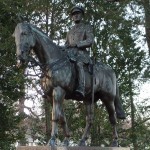

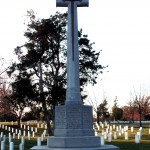
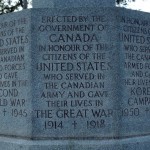
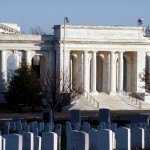
November 15, 2014
My Family in the First World War – Part 2: Hammie Neill
5/4732 Sergeant Hamilton Neill

Sergeant Hammie Neill
Hamilton Neill—known throughout his life as ‘Hammie’—was the younger brother of my great-grandfather William Neill. He served with The Royal Irish Rifles in the Militia, the Special Reserve, and the Regular Army for a little over 30 years and saw operational service during the South Africa War, the First World War, and the 1920 Iraqi revolt. The final six years of his service were spent in India attached to the 2nd Battalion, Bombay, Baroda and Central India Railway Regiment.
Hammie Neill was born on 5 September 1884 at Ballymacateer, County Down—you can read more about the family in the essay about William Neill. Like his brother, he worked as a weaver and it is known that in 1901 he was working for William Liddell & Company in Donaghcloney.[1]
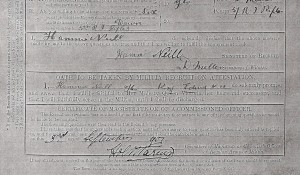
Hammie Neill’s Attestation in 1901
He enlisted into the Militia on 3 September 1901, just prior to his 17th birthday (he declared himself to be a year older), for a six-year engagement with the 5th Battalion (Royal South Down Militia), The Royal Irish Rifles.[2] He was allocated the regimental number 3209, and he served with ‘B’ Company.
Three months after his enlistment Hammie Neill was mobilised for service in the South Africa War. The 2nd Battalion had been mobilised for service in South Africa in October 1899 and the 5th Battalion was mobilised early in 1901; it embarked for the Cape on 5th April.[3] The men of the 5th Battalion were engaged largely in line of communication security duties, although the Battalion also formed a mounted infantry company that was used on raiding and ‘driving’ operations.
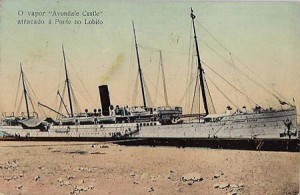
SS Avondale Castle
Hammie Neill was embodied for service on 3 January 1902 and embarked for South Africa on 13 February on the SS Dilwara[4] from Southampton. Unfortunately, nothing is known of exactly where he served with the 5th Battalion. At the end of the war, just over a year after its arrival in South Africa, the 5th Battalion was sent home and Hammie Neill returned on the SS Avondale Castle,[5] which left for England on 30 June 1902 and arrived Southampton on 23 July. For his service in South Africa he was awarded the Queen’s South Africa Medal, with clasps ‘ORANGE FREE STATE’, ‘CAPE COLONY’, and ‘1902’. He was paid the South African War gratuity of £5, and this period of 203 days counted towards his pensionable service.
On his arrival home he returned to work as a weaver. He was exempt from annual training with the Militia in 1903 but attended in each of the following years until his engagement ended on 2 September 1907, when Private Neill was duly discharged.
Whether missing the life as a part-time soldier or needing more money, Hammie Neill reenlisted two years later. By then the Army, in particular the volunteer forces, had undergone reorganisation—the Territorial and Reserve Forces Act, 1907 had reformed the Militia as the Special Reserve in 1908.[6] Hammie enlisted into the new Special Reserve on 23 September 1909 at Waringstown and rejoined the 5th Battalion;[6] he was allocated the regimental number 5/4732.
On 10 June 1911 Hammie married Sarah Watson at Shankill Parish Church in Lurgan. Sarah also worked in the linen industry; she was a veiner—a decorator of handkerchiefs with a form of drawn thread work. The family lived at 114 Victoria Street, Lurgan, with Sarah’s parents. Like the rest of the family, Hammie and Sarah signed the Ulster Covenant and the Declaration on 28 September 1912 (there is more about this in the essay about William Neill). Hammie and Sarah had one child, a daughter, Masie, who was born on 6 February 1913.
Every year prior to the First World War Hammie duly attended annual training at Ballykinler—the final training period took place from 8 June to 4 July 1914. War was declared on 4 August and he was mobilised two days later on 6 August; on 29 August he was promoted to Corporal. After a period of training and the issue of equipment, he departed for France in early November with a reinforcement draft destined for the 2nd Battalion.[8]
At the outbreak of war the 2nd Battalion had been based at Tidworth in 7th Brigade, 3rd Division, one of the five divisions allocated to the British Expeditionary Force. The Battalion landed at Rouen on 14 August 1914 and took part in the early actions of the war, culminating in the First Battle of Ypres in October and November. By 14 November it was in reserve near Hooge east of Ypres and had been reduced to a fighting strength of 130 all ranks. Over the next few days officers and men were sent to reinforce other battalions in the Brigade so that by 18 November the Battalion was only 40 strong. Having been relieved on the night of 19 November, this remnant of the Battalion marched 14 miles to the west of Ypres to Westoutre, where it was joined by the reinforcements on 21 November—three officers and 463 NCOs and men, including Corporal Hammie Neill.
His first stint in the trenches soon followed on 30 November near Kemmel; the first casualties from the new men occurred the next day when Rifleman James Patton[9] was killed and two others were wounded. For the next six months, the battalions of 7th Brigade rotated through the trenches at Kemmel, Vierstraat and St Eloi and the billets in Locre, Westoutre and La Clytte—no major actions were conducted during this period but there was a steady trickle of casualties suffered every day when the Battalion was in the trenches.
In June 1915 Hammie Neill experienced his first major action of this war—the attack on Bellewaarde Spur. On 4 June 1915 7th Brigade was relieved by 85th Brigade and moved to a bivouac area near Poperinghe. This period of ‘rest’ was short-lived and on 9 June the Battalion moved into the trenches at Hooge. In preparation for the attack, the Battalion was relieved on 11 June, although a significant number of men—B Company, some men of C Company and an attached machine gun team—had to wait until dark the following night before they could move out of the trenches.
The German position on Bellewaarde Spur (see map) was a strong salient into the British line, between the Menin Road and the Roulers railway. It was known as Bellewaarde Spur after the Bellewaarde Lake, which lay south of the shallow ridge. The aim of the attack was to capture this area of higher ground to straighten the British line and it was to be carried out by 9th Brigade, which would attack from Y Wood south-west of the spur. 7th Brigade, including 2nd Royal Irish Rifles, was to be in reserve west of Cambridge Road and would move forward to occupy and consolidate the captured German first line trenches.

Bellewaarde Spur
The 2nd Battalion’s war diary records:
June 15th
The Battalion paraded at 5.30 p.m. and marched to the assembly trenches between WITTEPOORT FARM and Railway to support 9th Infantry Brigade in an attack on BELLWAARDE SPUR. Strength:- 21 officers, 630 other ranks.
June 16th
The bombardment, by our artillery, commenced at 2.50 A.M., lasting until 4.15 A.M., when the 9th Infantry Brigade assaulted, carrying the first three lines of German trenches. The 2nd R. Irish Rifles supported the left – ‘C’ Company followed by ‘D’ Company on Right, ‘A’ Coy followed by ‘B’ Company on Left with orders to consolidate the first German line.
‘C’ and ‘D’ Companies, carried away by their keenness, pushed through to the 3rd line, closing up with the assaulting troops under Captain E.C. FARRAN & Lieutenant C.H.H. EALES. These companies were then re-organised and withdrawn in perfect order to the first line, which they put in a state of defence. ‘A’ Company, under 2nd Lieut. W.E. Andrews was similarly engaged on the left.
Owing to heavy artillery fire which soon developed, ‘B’ Company was unable to follow ‘A’ Coy quickly. They were formed up on CAMBRIDGE Road 250 yards behind, preparatory to making another effort to get through, when they were unfortunately shelled by enfilade fire causing 30 or 40 casualties. The remainder of the Company was then withdrawn and kept in battalion support for the remainder of the day.
During the day, from early morning to nightfall, the Battalion was subjected to a terrific artillery bombardment. The Non-commissioned Officers and men of all companies distinguished themselves by their discipline, coolness and steadiness under most trying circumstances.
At no time during the day could it be said that they were in any way shaken by their ordeal. For instance, at 3.30 pm, after hours of bombardment, ‘C’ and ‘D’ Companies with very short notice were called upon to attack. It possessed just as much spirit and dash as their early morning attack. Both of these attacks were gallantly led by Captain E.C. FARRAN, who was wounded and became missing and 2nd Lieut. C.H.H. EALES, who was uninjured.
‘A’ Company consolidated and held, in a most determined manner, the left flank of the German trenches, and handed them over intact to the Royal Scots who relieved them at midnight.
2nd Lieut. Andrews, who commanded this portion of the line, deserves the highest praise for the able way in which this difficult operation was carried out. The Battalion was relieved at 1.29 A.M. having acquitted itself in a manner which has called forth praise from the Corps Commander.[10]
The attack cost the Battalion 13 officers and nearly 300 other ranks killed and wounded. Among the wounded was Corporal Hammie Neill, who was shot in the left shoulder. He was evacuated through the medical system and left France for hospital in the United Kingdom on 17 June.
While in hospital he was held on the strength of the Depot and on 12 August, having been treated and found fit for general service, he joined the 5th (Extra Reserve) Battalion at Holywood.[11] Here he was appointed Lance Sergeant on 30 December 1915. His conduct when at the 5th (Extra Reserve) Battalion was not all that it should have been and he was deprived of his appointment as Lance Sergeant on 19 February 1916 for ‘misconduct’. From 13 to 24 March he attended a course of instruction at the ‘Bombing School’—the Irish Command Grenade School at Elm Park House, Dublin.[12] Later, his conduct again fell short of that expected of an NCO of his experience and on 5 May he was tried by Regimental Court Martial[13] accused of ‘when on active service, neglect to the prejudice of good order and military discipline’—the detail of his ‘neglect’ is not known. He was found guilty and reduced in seniority, his rank of Corporal now being dated 29 April 1916. His offence cannot have been too serious because he was reinstated as a paid Lance Sergeant the following day, 6 May.
Hammie Neill returned to France on 2 August 1916 and rejoined the 2nd Battalion.
In October 1915 7th Brigade had transferred to 25th Division and a week later 2nd Royal Irish Rifles transferred to 74th Brigade in that Division. When Hammie rejoined—in a draft of 29 men on 5 August—the Battalion was in billets in Bertrancourt. On 8 August he was back in the trenches, this time at Auchonvillers, opposite the German positions at Beaumont-Hamel; this was less than two miles from Hamel, where his brother William had taken part in the attack on 1 July. Later that month the 25th Division moved south of the River Ancre and took part in the Battle of the Ancre Heights, although 2nd Royal Irish Fusiliers was in reserve throughout.
By early November the Battalion was back in Belgium, this time near Ploegsteert Wood. It would spend the winter and spring of 1917 here. Hammie Neill’s experience over the next two years was typical of the infantry man’s lot—periods of trench life holding the line interspersed with major actions. The 2nd Battalion suffered a considerable number of casualties over this period but Hammie Neill manage to survive unscathed. He was promoted to Sergeant on 1 June 1917 a few days before the attack at Messines. That was the first of a series of actions fought by the 2nd Battalion:
7 June 1917 – The Battle of Messines. The Battalion captured all of its objectives, at a cost of 16 killed in action—nine died of wounds the following day—and a further 216 were wounded. Following the attack, the Battalion was withdrawn from the line on 11 June, having sustained a further 24 casualties.
10 August 1917 – The Capture of Westhoek during the Third Battle of Ypres. The attack by 2nd Royal Irish Rifles was a success but, again, at terrible cost. The war diary records that Battalion had gone into the line on 5 August with a strength of 15 officers and 479 other ranks; its strength when it came out of the line on 11 August, which included some men who were wounded but able to remain at duty, was ten officers and 148 other ranks.
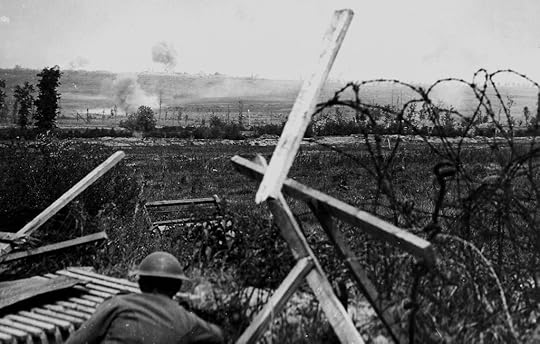
Shells falling on Messines
(On 13 November 1917 2nd Royal Irish Rifles was transferred to 108th Brigade in 36th (Ulster) Division, where Hammie Neill joined his brother, William, who was serving with the 9th Royal Irish Fusiliers, and where the Battalion absorbed 7th Royal Irish Rifles, which had joined the Ulster Division from 16th (Irish) Division a month earlier.)
22/23 November 1917 – The Battle of Cambrai. Initially in reserve, the Battalion took part in the unsuccessful attack at Moeuvres on 23 November. Casualties were relatively light—127 officers and men were killed, wounded and missing.
(When the infantry of the BEF was reorganised in February 1918, the 2nd Battalion moved to 107th Brigade, where it joined the 1st Battalion and 15th Royal Irish Rifles. It remained in 107th Brigade until the war ended.)
21-28 March 1918 – The withdrawal from St Quentin during the German spring offensive—the Kaiserschlacht (Kaiser’s Battle). In this period the Battalion suffered 715 officers and men killed, wounded and captured.
After spending the summer of 1918 in the line north-west of Bailleul, Sergeant Hammie Neill was posted home to the Depot on 12 September 1918 at the end of his period of engagement but, in accordance with The Military Service Act, 1916 (Session 2), which allowed for the continuation in service of time-expired men, he was re-enlisted and, for his troubles, awarded a £15 bounty.
He was at the Depot when the war ended and he decided to remain in the Army; he was discharged from his wartime engagement on 10 February 1919 and enlisted into the Regular Army for service with The Royal Irish Rifles. He joined the 3rd (Reserve) Battalion at Rugeley in Staffordshire on 30 May and rejoined the 2nd Battalion on 30 June 1919, when it was reformed at Thetford.[14]

Medal Index Card for Sergeant Hammie Neill
Operations by the Allies against the Central Powers had been fought in Mesopotamia, largely between troops of the Indian Army and troops of the Ottoman Empire, between November 1914 and November 1918. At the end of the war the Ottoman Empire was partitioned and Britain was granted the mandate over Mesopotamia. A British Army garrison was established in various parts of the country—the 2nd Battalion, The Royal Irish Rifles sailed for Mesopotamia on 18 September 1919 to join the garrison. Sergeant Hammie Neill arrived with the Battalion on 15 October and was based initially near Baghdad. The Battalion had been joined by the wives and families of the married men and in the early part of 1920 they all moved to Kerind, in the Persian hills to the east of Mesopotamia, where the climate was much kinder.
All was not well, however, and from the early summer in 1920 a revolt spread throughout much of Mesopotamia that resulted in some brutal fighting. The 2nd Royal Irish Rifles was deployed to the fertile region along the Euphrates near Najaf, about 100 miles south of Baghdad while the families awaited evacuation to India. The Battalion was part of the column that marched south from Hillah to relive Rumaitha. It then took part in the defence of Hillah and later was engaged in another relief operation at Kufah. These operations drew to a close in October, and in February 1921 the Battalion, now the 2nd Battalion, The Royal Ulster Rifles, moved into Hinaidi Cantonment, near Baghdad. For his service in Iraq he was awarded the General Service Medal 1918-62, with clasp ‘IRAQ’.
In May 1921 the Battalion moved to Egypt. Little is known about Hammie Neill’s time in Egypt other than he qualified as a rifle and bayonet instructor on a course of instruction at Zeitoun Camp, near Cairo between 1 July 1921 and 20 August 1921, and was attached to the 2nd Battalion, The Highland Light Infantry from 28 November 1923 until he returned to the United Kingdom on 15 January 1924 to take up an appointment as Provost Sergeant at the Depot at Victoria Barracks, Belfast.
When this period of duty ended he sailed for India and rejoined the 2nd Battalion, The Royal Ulster Rifles, now at Wellington in Madras (now Tamil Nadu), on 19 February 1927.
On 16 November 1927 Sergeant Hammie Neill was transferred to the non-departmental section of the Indian Unattached List—those men detached for duty with the Indian Auxiliary and Territorial Forces—and posted as a Staff Sergeant Instructor to the 2nd Battalion, Bombay, Baroda and Central India Railway Regiment, based at Ajmer Cantonment in Rajasthan.[15]

The cap badge of the Bombay, Baroda and Central India Railway Regiment
The Regiment comprised two battalions—the 1st Battalion had its headquarters at Lower Parel in Bombay (Mumbai)—and it was manned by part-time, paid, volunteers, who were all European and Anglo-Indian, and most of whom were employees of the railway. The Adjutant, Quartermaster and the Staff Sergeant Instructors were attached from the British Army battalions throughout India. These railway battalions were responsible for the security of key points and stations when mobilised.
Staff Sergeant Instructor Hammie Neill spent the final six years of his military service in Rajasthan with this battalion of the Auxiliary Force. He re-enlisted on 2 February 1931 in order to complete 21 years’ service but sought to be discharged at his own request sometime in 1933. He had been awarded the Regular Army Long Service & Good Conduct Medal on 25 April 1933[16] and on 27 December he left India. He was discharged from the Army on 9 January 1934.
His final testimonial by Major A H M Campion,[17] commanding 2nd Battalion, Bombay, Baroda and Central India Railway Regiment, read:
‘A good type of man whose 14 years service in the Army has shown him to be honest, self reliant and trustworthy. He has acted as Provost Sergeant at his Depot and for the past 6 years has been a Staff Sergeant Instructor with the Indian Auxiliary Force where in a position of responsibility and trust he has given every satisfaction.’
Hammie Neill lived subsequently in Northern Ireland. His last years were spent at 14 Cliftonville Street, Belfast, where he died on 27 August 1959, aged 74.
His medals, earned in over 30 years’ service are:
Queen’s South Africa Medal, with clasps ‘ORANGE FREE STATE’, ‘CAPE COLONY’, and ‘1902’; 1914 Star, with clasp ‘5TH AUG.-22ND NOV. 1914’; British War Medal 1914-20; Victory Medal; General Service Medal 1918-62, with clasp ‘IRAQ’; Army Long Service & Good Conduct Medal, GVR.
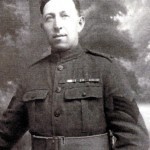
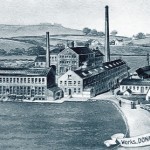

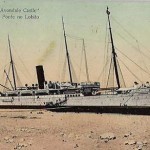
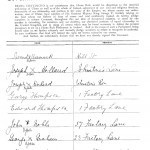
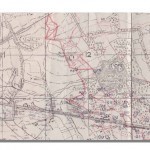
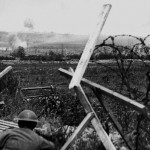
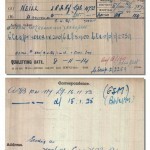
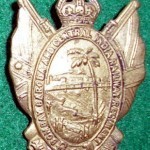
Acknowledgments:
Ian Boyle, Simplon Postcards, for the image of the SS Avondale Castle.
Imperial War Museum for the photograph of Messines.
Liddell International for the image of the Donaghcloney Mill.
Martin Harrison for the image of the Bombay, Baroda and Central India Railway Regiment Badge.
Sources:
The Ulster Covenant Public Record Office Northern Ireland
War Diary, 2nd Battalion, The Royal Irish Rifles. National Archives. WO 95/1415/1, WO 95/2247/1, & WO 95/2502/4.
Jackson, D. (1940). India’s Army. London: Sampson Low.
1. (Back) The company was established in 1866 and became the largest Irish linen jacquard weaving company in Ireland. It is still in operation producing the highest quality linen and cotton products.
2. (Back) The Royal Irish Rifles had been formed in 1881 as a consequence of the Cardwell Reforms, which restructured the British Army. The 83rd (County of Dublin) Regiment of Foot and the 86th (Royal County Down) Regiment of Foot amalgamated to become, respectively, the 1st and 2nd Battalions, The Royal Irish Rifles. The reforms also aligned militia units with the county regiments. In this case the Royal North Down (Rifles) Militia became the 3rd Battalion (Royal North Down Militia), with its headquarters at Newtownards; the Antrim (Queen’s Royal Rifles) Militia became the 4th Battalion (Royal Antrim Militia), with its headquarters at Belfast; the Royal South Down Militia became the 5th Battalion (Royal South Down Militia), with its headquarters at Downpatrick; and the Louth (Rifles) Militia became the 6th Battalion (Louth Militia), with its headquarters at Dundalk.
3. (Back) The 2nd Battalion arrived at the Cape in November 1899. It did not enjoy success in its early engagements—in its first action at Stromberg in December it suffered over 250 casualties and the following April a large part of the battalion was captured at Reddersburg. For the rest of the war it was engaged largely in ‘blockhouse’ duties, although it formed two companies of mounted infantry that performed well in raiding operations. It was reinforced later by men of the Militia from the 5th Battalion. Most of these men returned to the 5th Battalion after its arrival in South Africa.
4. (Back) The SS Dilwara was a passenger cargo vessel built in 1892 on the Clyde. It was operated by the British India Steam Navigation Company Ltd.
5. (Back) The SS Avondale Castle was a passenger cargo vessel built in 1897 on the Clyde by Fairfield Govan and was owned and operated by the Union Castle Mail Steam Ship Company from 1900.
6. (Back) The Act had resulted in only one change to the make-up of The Royal Irish Rifles—the disbandment of the 6th Battalion (Louth Militia).
7. (Back) You can read more about the Special Reserve here.
8. (Back) For an excellent history of the 2nd Battalion see: Taylor, J W. (September 2005). The 2nd Royal Irish Rifles in the Great War. Dublin: Four Courts Press.
9. (Back) 6612 Rifleman James Patton was also a soldier of the Special Reserve. He has no known grave and is commemorated on the Menin Gate Memorial at Ypres.
10. (Back) Captain Edmond Chomley Lambert Farran was killed in action on 16 June 1915. He is commemorated on the Menin Gate Memorial, Ypres.
Lieutenant Charles Herbert Harberton Eales, Indian Army, attached Royal Irish Rifles, was awarded the Military Cross (London Gazette. (14 January 1916). Issue 29438, p 587.) Lieutenant Colonel C H H Eales MC was killed whilst on duty in command of the Mahe garrison in the Seychelles on 5 March 1941 during the Second World War. He is commemorated on the Brookwood Memorial.
Captain William Ernest Andrews was killed in action on 2 August 1915 by shellfire, which also killed Lieutenant Arthur Augustus Raymond, Lance Corporal Joseph William Tatam and Private John Kearney. Two other officers and two soldiers were wounded. He was buried at Lankhof Chateau but his grave was destroyed in later fighting and he is commemorated on a memorial in White House Cemetery, St Jean-les-Ypres. The others are commemorated on the Menin Gate Memorial, Ypres.
11. (Back) The 5th Battalion had become the 5th (Extra Reserve) Battalion when it mobilised at Downpatrick on 4 August 1914. In May 1915 it had moved to Holywood.
12. (Back) The area occupied by the ‘Bombing School’ is now a golf course, where some of the practice trenches can still be seen.
13. (Back) The regimental court martial was used to try other ranks who were charged with lesser offences. It was limited in its powers of punishment and records were not sent to the Judge Advocate General’s Office; often the only record of proceedings is that contained in the soldier’s record.
14. (Back) In August 1920 when the British Army replaced regimental numbers with army-wide personal numbers, Hammie Neill was renumbered as 7006111.
15. (Back) The Rajputana-Malwa Volunteer Rifle Corps was raised on 2 August 1882 and associated with the Rajputana-Malwa State Railway. In 1887 it amalgamated with the the Bombay, Baroda and Central India Railway Volunteer Rifle Corps (which had been raised on 3 August 1877 and amalgamated with the Ghadeshi Volunteer Rifle Corps in 1886) to become that Corps’ 2nd Battalion. In April 1917 the two battalions became 1/17th and 2/17th Bombay, Baroda and Central India Railway Battalion, India Defence Force. In 1920 the Auxiliary Force Act, 1920 created the new, all-volunteer Auxiliary Force and they became the 1st and 2nd Battalions, Bombay, Baroda and Central India Railway Regiment, Auxiliary Force, India.
16. (Back) India Army Order No. 216, dated 25 April 1933.
17. (Back) Major Arthur Havard Montriou Campion was born on 13 April 1887 in Dera Ghazi Khan, Bengal, India. He was a civil engineer by profession and served before the First World War as a Lieutenant in the 1/17th Bombay, Baroda & Central India Railway Volunteer Rifle Corps. During the war he served with 111th Railway Company, Corps of Royal Engineers in France and on the staff of the Assistant Director of Railway Construction. After the war he returned to India and continued to serve with the 2nd Battalion, Bombay, Baroda and Central India Railway Regiment.
Back to My Family in the First World War.
October 28, 2014
Cadet John Dunn IV
This is part of a series of essays about the First World War casualties commemorated by the Commonwealth War Graves Commission in Virginia.
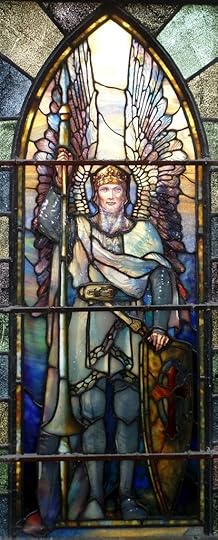
The memorial window by Tiffany Studios in All Saints’ Episcopal Church, Richmond dedicated to Cadet John Dunn IV, Royal Flying Corps
The state of Virginia is rich with beautiful windows and other commemorative and decorative pieces from the studio of Louis Comfort Tiffany. There are so many sites of interest that the Virginia Museum of Fine Arts offers advice on driving tours to see them.
In Richmond, the state capital, one such window commemorates Cadet John Dunn, Royal Flying Corps, who died of scarlet fever on 26 March 1918, aged 20. When it was dedicated at All Saints’ Episcopal Church on 22 December 1918, it became the first war memorial to be placed in the city to commemorate a casualty of the First World War.
The window features a representation of St Michael and has been described, somewhat portentously, as:
‘…a bold and impressive conception of the heroic figure of St. Michael, the archangel, who, according to the twelfth chapter of Revelation, fought with his angels against the Dragon, ‘that old serpent called the Devil,’ and cast him out of Heaven. The heavenly Knight, vibrant with youth and high courage, is clad in burnished armor and holds in his right hand a long and slender lance. Peace and victory achieved through battle in a holy cause are expressed in the post, of the noble figure and the clear and level gaze of eyes which have looked on death unafraid.’[1]
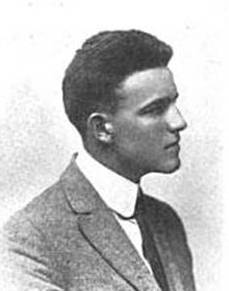
John Dunn IV
John Dunn IV was born on 10 March 1898 at Richmond, Virginia, the only child of John Dunn MD and his Canadian-born wife Nellie (née Porterfield). The family lived at 411 East Franklin Street; also living with the family was Nellie’s sister Jonnie. He was educated at McGuire’s University School in Richmond and studied at the University of Virginia (Class of 1918) but left in January 1918 to enlist. He attested on 25 January, joined the Royal Flying Corps (Cadet, 154472), and was sent immediately for training at Burwash Hall, Toronto.
The training in Canada of pilots for the Royal Flying Corps had begun in 1917. In addition to prospective Canadian pilots, this facilitated the flying ambitions of those young men in the United States, like Dunn, who wished to join the Royal Flying Corps, rather than the fledgling Aviation Section, United States Signal Corps. In addition to flying stations, the RFC established an aeronautical school to provide the training that pilots required before taking to the skies. The School of Military Aeronautics, No. 4 was based in Burwash Hall at the University of Toronto.[2]
John Dunn fell ill with scarlet fever at Burwash Hall a few days before he died at 3.00pm on Tuesday 26 March 1918 in the Military Base Hospital, Toronto. His body was repatriated to Richmond and interred at Blandford Cemetery, Petersburg on Good Friday, 29 March.
Blandford Cemetery is the second largest in Virginia, after Arlington National Cemetery. It was established in the early 18thC and amongst those interred here are the only British general of the American Revolutionary War buried in the United States—Major General William Phillips—and 30,000 Confederate casualties from the Civil War. In the cemetery stands Blandford Church (Old Blandford Church of Bristol Parish). The church was built in 1735 but was abandoned in 1806. It was restored in the latter part of the 19thC and, between 1904 and 1912, memorial windows by Tiffany Studios were installed to commemorate the Civil War dead of the eleven Confederate states and the border states.
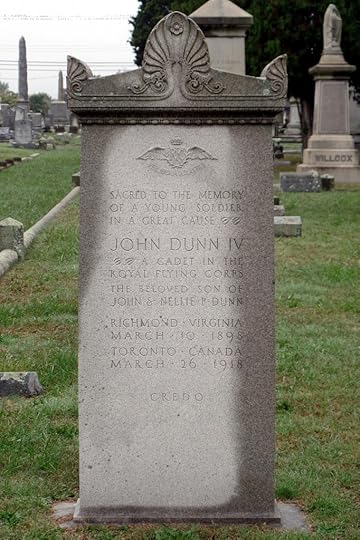
The grave of Cadet John Dunn IV in Blandford Cemetery, Petersburg
The grave of Cadet John Dunn is marked by a private memorial in the family plot on the western side of the cemetery, on the cemetery’s Carolina Avenue. He is buried alongside his parents and nearby is the grave of his aunt, Jonnie Porterfield, who commissioned his memorial window in All Saints’ Episcopal Church.
The original All Saints’ was built on Madison Street in 1887. This was replaced by a new church at 316 West Franklin Street in 1901. It was in this church that the window dedicated to John Dunn was first installed. It was later paired with a window dedicated to Lieutenant David Adam Wallace, United States Army Air Forces, who was killed in action on 10 March 1943. The church moved again in April 1955 to its present location at 8787 River Road. Both windows, and many others by Tiffany from the old church, were moved to the new building. The window commemorating John Dunn is in the pulpit-side ambulatory, and that for David Adam Wallace is in the lectern-side ambulatory. Both men are listed on the two large bronze plaques mounted at the rear of the church nave, which commemorate parishioner deaths in the First and Second World Wars.
The dedication, part of the original window design, read:[3]
PER – ARDUA – AD – ASTRA
TO THE GLORY OF GOD AND IN LOVING
MEMORY OF JOHN DUNN IV CADET ROYAL
FLYING CORPS NO 154472 + MARCH 10TH
1898 – MARCH 26 1918 + FOR SEVEN YEARS
A COMMUNICANT IN THIS CHURCH
CREDO
That part of the window was not installed in the new church and beneath the window is now a simple brass plaque that reads:
To the glory of God
and in loving memory of
JOHN DUNN IV
March 10, 1898 March 26, 1918
John Dunn was also commemorated in the Honor Roll of the University of Virginia, which was published in Volume 32 of Corks and Curls, the university’s annual yearbook for 1919, and which listed sixty-five men who had ‘perished in the bloody throes of war’; the Honor Roll was acknowledged as being incomplete.[4] By the time of the dedication of the university’s memorial in 1921 the Honor Roll had grown to 80 names. The dedication of the bronze memorial tablet—a gift of the Classes of 1918, 1919 and 1920 and of the Seven Society—took place in the Rotunda at the University of Virginia on 1 June 1921.[5] Subsequently, the university produced a comprehensive account of the university and its alumni in the war.[6]
In 1919, Arthur Kyle Davis, then a graduate student and an editor of the university magazine, The Virginia Spectator, and later professor of English at the university specializing in American folklore, wrote a heartfelt poem dedicated to his friend John Dunn:[7]
War Claimed
Firm friend and comrade of my college years
Is gone; ‘twas the price of his brave carefree heart
That could not bear to waver in his part
When others went, nor heard their loved ones’ tears.
‘Twas not for praise, nor for his comrades’ cheers
He left home, friends, position, future—all;
He unresisting heard a deeper call
And answered; he must fight; he knew no fears.
Heroic in his splendid sacrifice,
He died with courage, as a brave man dies;
A destined hero of the battle line,
Death came too soon, and he could but resign;
A soul so pure that (reverently I say)
If he must die, Good Friday was the day.
Cadet John Dunn is also commemorated in Canada’s First World War Book of Remembrance.[8]
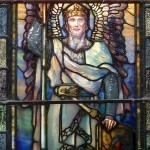
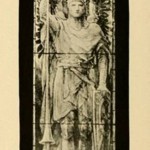
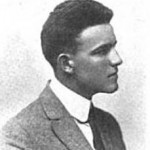
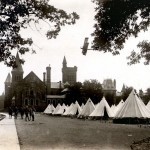
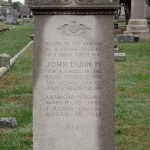
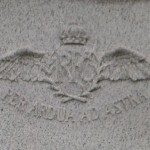
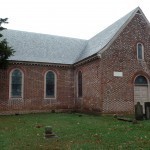

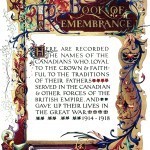

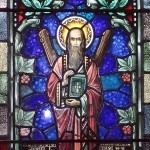
Acknowledgements:
Lori Humrich, Office Manager, All Saints Episcopal Church for her tour of the church and its impressive Tiffany windows.
1. (Back) ‘First Memorial for Richmond. Window for John Dunn IV to be dedicated at All Saints’ Sunday.’ (19 December 1918). Richmond Times Dispatch.
2. (Back) For a full account of the Canadian-based flying training programme see: Hunt, C W. (2009). Dancing in the Sky: The Royal Flying Corps in Canada. Toronto: Dundurn.
3. (Back) ‘St. Michael a Reproduction of the Sketch for a Tiffany Favrile Glass Figure Window to be Installed in All Saints Church, Richmond, Virginia, in Memory of John Dunn, IV, a Cadet of the Royal Flying Corps.’ (1919). Tributes to honor : suggested types of memorials by the ecclesiastical department of the Tiffany Studios. New York: The Firm.
4. (Back) ‘Honor Roll’. (1919). Corks and Curls. Volume 32. p 33. Charlottesville: University of Virginia.
5. (Back) For a full account of the dedication of the First World War memorial see: Metcalf, J C. (1922). The centennial of the University of Virginia, 1819-1921: the proceedings of the Centenary celebration, May 31 to June 3, 1921. New York: G P Putnam’s Sons, The Knickerbocker Press.
6. (Back) Patton, J S. (January 1922). The University of Virginia in The World War. The Alumni Bulletin of the University of Virginia, Volume 15, Issue 1. p 47.
7. (Back) Davis, A K. (January 1919). War Claimed. The Virginia Spectator, Volume LXII, Number 1. p 204. Charlottesville: Virginia Spectator Incorporated.
8. (Back) Information about Canada’s Books of Remembrance may be found here.
Evacuation from Sierra Leone
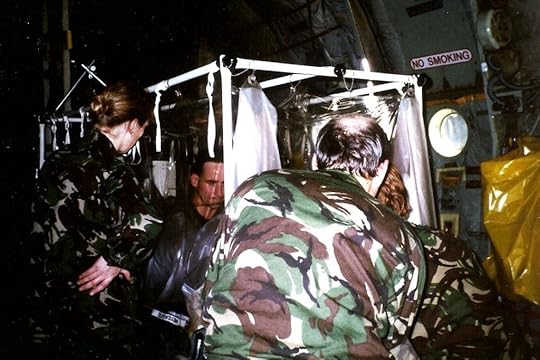
Evacuation – My ‘bubble’
The Ebola epidemic in west Africa is the largest outbreak of the disease since its identification in 1976. The region is also afflicted with other viral hemorrhagic diseases, most of which will lead to death if untreated. One of these is Lassa fever, first ‘discovered’ in the town of Lassa, Nigeria in 1969.
In 2000, while serving with the British Army in Sierra Leone, I succumbed to malaria. During my stay in the Indian Army hospital supporting the United Nations force I developed an unusual fever and throat infection, which the doctor looking after me diagnosed as the early stages of Lassa fever.
This was the second deployment of the Joint Force Headquarters to Sierra Leone. We had mounted a successful operation in May (Operation PALLISER) in response to the attacks by the Revolutionary United Front—the rag bag collection of bush fighters that terrorised the country for over a decade—and had returned in October to bolster the British training presence in order to tackle an upsurge in violence.
In early November 2000 I was within 24 hours of boarding an aircraft to return to the UK at the end of the deployment when I developed a fever and all the symptoms of malaria. I was furious. We were all experienced in this environment and religiously took our prophylactic drugs, covered our skin in the evenings and slept under nets. Our nurse, a young RAF Flight Lieutenant, immediately dispatched me to the United Nations hospital on the other side of Freetown. This was an Indian Army hospital manned by turbaned male Sikh nurses and a few young female nurses. My doctor was experienced and capable and, notwithstanding my adverse reaction to his initial malarial treatment, which made me physically sick and as weak as a kitten, he got my temperature under control and soon pronounced that the malaria was being beaten. I then developed another high fever; this one was constant, not cyclical like a malaria fever. I also had a throat infection and I ached all over. The doctor diagnosed Lassa fever—he had another case in the hospital, a Nigerian soldier—and he moved me into an isolation room.
I was told about the diagnosis by the British doctor of the staff of the JFHQ. He was a peer and a really great bloke. His bedside manner was tough and to the point. He said: “It looks like you have Lassa fever, which is like Ebola and there’s a good chance it will kill you. But the drugs seem effective and we’ll start them this afternoon.” My first thought was, “Why are you waiting until this afternoon?”
The news of my diagnosis and incarceration soon spread and I was visited by a good friend who passed in to my room a television and a video player that he had ‘borrowed’ from one of the officers posted to Sierra Leone on the staff of the training mission. Jacqui, who had ‘donated’ the TV & video player, is an experienced logistician; she is now a civilian and, as I write this, she is back out in Sierra Leone assisting with the operation to combat the Ebola crisis.
It had been decided that I was to be ‘casevaced’. This was to be the first occasion that the Royal Air Force Tactical Medical Wing had deployed with their isolation ‘bubble’ to evacuate a real casualty of this kind. It was quite an experience. I have to say that throughout this I was quite well. The drugs had had an effect and my temperature was under control, I was weak but in reasonable shape physically and fine mentally.
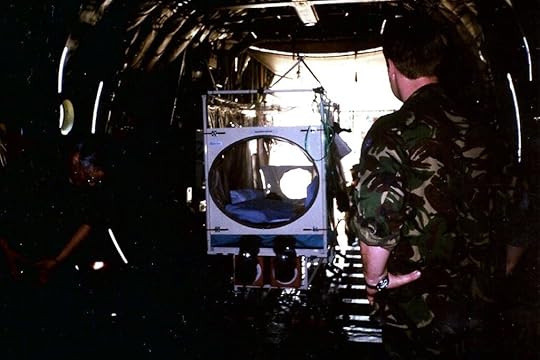
Evacuation – The RAF Tactical Medical Wing Isolation Chamber on the C-130 that evacuated me from Sierra Leone
Within a day or so the planning for my evacuation had kicked in and the Joint Headquarters at Northwood had dispatched the nursing team in a C-130 to evacuate me. As far as I remember the team comprised a couple of doctors, a nurse (who was quite clearly ‘in charge’ if not in command) and an anaesthetist. The aircraft landed at Lungi airport, about 15 miles from the hospital across the bay where the Sierra Leone River met the Atlantic Ocean. The only way to move me to the aircraft was by helicopter.
In preparation for my trip to the UK the anaesthetist came to my room with the nurse and I was told what was going to happen. I couldn’t quite envision the ‘bubble’ but the procedure to get me to it was simple enough. In case I needed any intravenous treatment during the flight the anaesthetist planned to put a cannula into a vein in my arm. I suppose it might have been natural to be nervous around me. He was masked but shaking like he had palsy. I was not confident that this phase was going to go well. As he turned to me, his syringe, with which he was going to inject anaesthetic at the site of the cannula insertion, flicked out of his hand and, in what appeared to be a slow motion scene from a film, spun in the air and embedded itself in the toe of his boot. It quivered there like a cartoon pirate’s dagger stuck in a table. His first words were, “I don’t think we need to mention this to anyone, eh?” He finally inserted a cannula on the back of my wrist where the wrist bends—I still have the scar it left.
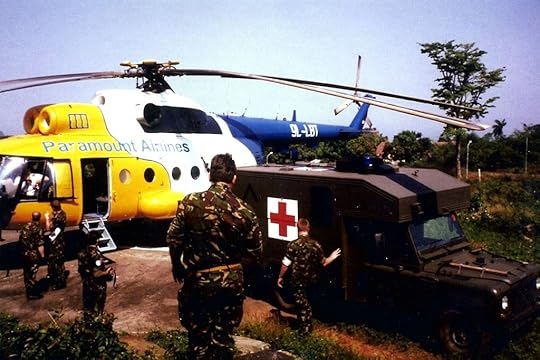
Paramount Airlines MI-8, 9L-LBT, waiting to ferry me from hospital to Lungi Airport
My flight to Lungi was to be in one of the Ukrainian-crewed MI-8 helicopters of Paramount Airlines—it was the same helicopter that crashed in June 2007 killing all but one of the 23 on board. I had asked that I travel in uniform rather than having my bum hang out of the hospital robe that was my only clothing and, having changed into uniform trousers, boots and a T-shirt, I donned my surgical mask and walked to where the helicopter had landed. I was escorted by the RAF nurse from the casevac team and our own nurse from JFHQ, who had been superb throughout my stay in isolation. I was somewhat surprised by the number of people who had come out to watch. The aircrew were in masks also—one had it over his headset microphone, which plagued him throughout the flight—and without any fuss we took off and headed out over the bay to Lungi.
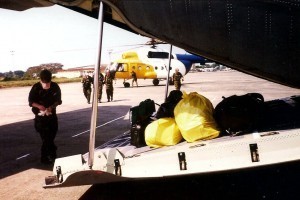
Being aided across the tarmac at Lungi airport prior to my flight to UK
As we reached the airport I could see the C-130 on the dispersal. The ramp was down and there were a few people milling about. We landed and I walked over to the aircraft with two of the medical team. At this stage the only thing on my mind was to make sure that all of my kit was there. I knew that some of it had been destroyed but I hoped that the items that I hadn’t been in contact with since falling ill had been packed and would travel to UK with me. The loadmaster showed me what he had been given—everything was there, including the hardwood carving that I had bought a few days before going to hospital.
I walked up the rear ramp of the aircraft to see my ‘bubble’ for the first time. It was a little smaller than a single bed and with enough room inside to sit up. What was not clear was how I was going to get into it. Luckily I was fit enough to just climb in and the flap was sealed behind me. No-one had catered for the heat. It was roasting hot on the concrete outside the aircraft. Inside it was hotter still and in my plastic greenhouse the temperature was extreme. I immediately began to sweat and within minutes my clothes were soaked; I then created my own cloudy eco-system. The temperature differential was such that the bubble steamed up and whenever any of the medical team wanted to talk to me I had to wipe a hole clear to see them.
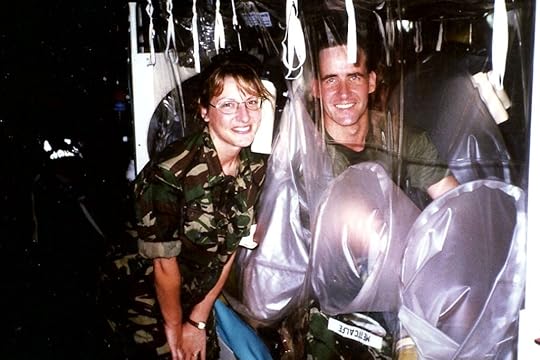
In the bubble and about to say goodbye to our JFHQ nurse
After a photo with my indefatigable JFHQ nurse and a waved goodbye, the ramp of the C-130 went up and we were off. The team, very thoughtfully, had put some magazines inside the bubble and a packed lunch. They had also put in a set of hospital pyjamas and I was able to change out of my soaking T-shirt. Unfortunately I had to keep it inside the bubble with me so it sat at the foot of the stretcher bed and steamed until everything cooled down as we reached our cruising altitude.
Our destination was Newcastle. There are only three hospital beds in the UK that can provide the level of isolation required, and the single bed in the Royal Victoria Infirmary was to be my new home. We had left Sierra Leone on a hot, tropical afternoon and we landed in Newcastle in driving, horizontal, ice-rain. As the ramp went down we saw the ambulance that would transport me to the hospital. Inside the open back door we could see a smaller version of my bubble on a wheeled stretcher. The four person medical team were in white protective suits and masks and were clearly sheltering from the horrible weather.
When the ramp was down and everyone ready, the hospital medical team were signalled and, like an amateur bobsleigh team, leapt out of the ambulance pushing the wheeled stretcher at a goodly sprint across the tarmac and up into the aircraft.
Now came the awkward bit. It was obvious that the procedure to move me from ‘my’ bubble to the stretcher bubble hadn’t been practised. The new medical team talked about it as if I wasn’t there and were somewhat surprised when I joined the conversation and said that they should join the bubbles together and I’d crawl into the new one. We duly manage that and then, after a hurried goodbye and thank you to my outstanding RAF medical team, it was off at a fast walking pace through the rain to the ambulance.
The worst part of the transfer to the stretcher had nothing to do with the medical team or the transfer itself. It was the photographer who had appeared and who wanted pictures of me in the bubble. He tried to attract my attention by whistling and repeatedly saying, “Oy, mate, look over here.” After a few minutes of this, while I was trying to work out how the transfer to the stretcher bubble would be done, I snapped and told him that if he didn’t ‘get lost’ (or similar words), I’d get out of my bubble and shove his camera where it would need the attentions of the medical staff to remove it.

Isolation Bed
I could write much more about the next part of the journey and my stay in Newcastle’s Royal Victoria Infirmary but suffice it to say it was an amazing experience. The nursing staff were superb in every regard, my hospital bubble was spacious, I was well enough to find the whole thing fascinating and, best of all, I was only there for two weeks. There was some dispute over what had caused my fever. It seems certain that it was not Lassa fever, thankfully, but an infection of unknown origin or type, probably picked up in the jungle hospital in Sierra Leone.
I am grateful that I had such a swift diagnosis of my malaria, a capable and experienced tropical medicine team in the Indian hospital, and that the RAF and NHS medical teams demonstrated incomparable professionalism, good humour and kindness at every stage of my treatment. I am also privileged to know people like Jacqui who, after a lifetime of military and civilian service in troubled places, is back in Sierra Leone doing what she does best. I never did find out what happened to her video player.



